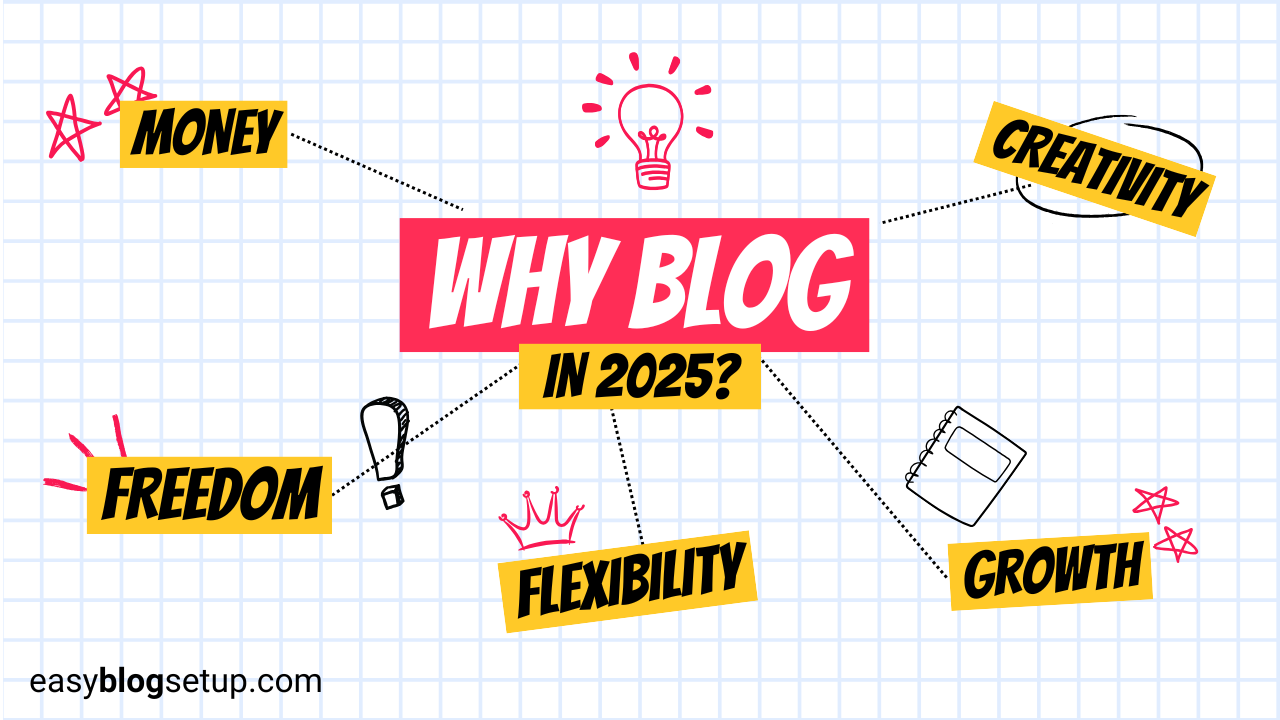
How to Start Blogging & Make Money in 2025 (Easy Blog Setup)
Last updated: Mar 4 , 2025

Manav
Editor

What is a Blog?
(And Why It’s Way More Than Just a Website)
You’ve got stories to tell. Opinions to share. Maybe knowledge that can save someone time, money, or even heartbreak.
Now imagine a place where all of that lives, where people from around the world can find YOU, learn from YOU, and trust YOU.
That’s not just a blog. That’s your digital home.
So, what is a blog, really?
A blog is a regularly updated website or web page that’s written in a conversational, personal, or informative style.
It’s where creators, experts, hobbyists, and everyday people write content (aka blog posts) about topics they’re passionate about from travel, fashion, finance, and fitness to tech, parenting, personal growth, and literally anything else under the sun.
Think of a blog as:
- Your voice on the internet
- Your personal brand’s HQ
- A platform that works for you 24/7 (yes, even while you sleep!)
- A long-term money-making machine if done right
Whether you’re into dog grooming or data science, your blog becomes your space and in 2025, that’s powerful.
A Little History, Real Quick
The term “blog” originally came from “web log.” It started in the late ’90s as online journals think digital diaries.
But today? Blogs are:
- Full-blown businesses
- Content engines for entrepreneurs
- Lead magnets for coaches, creators, and freelancers
- Online portfolios for artists, writers, and photographers
- And yes, still personal journals too (but way cooler now)
But Wait! Is Blogging Still Relevant in 2025?
Oh, absolutely. Here’s why:
- People crave real, human content over robotic social media ads.
- Google still LOVES helpful blog content.
- Blogs are where trust is built and trust leads to clicks, sign-ups, and sales.
- You own your blog. No algorithms can shut you down or shadowban you.
- Blogs are evergreen. A post written today can bring in traffic and money for years.
Real Talk: Why Do People Start Blogs?
Because they want more.
- More freedom: to work from anywhere.
- More impact: to help people through words.
- More income: to ditch the 9-to-5 or build a side hustle.
- More control: to be their own boss and call the shots.
Blogging is not just writing. It’s storytelling, sharing, selling, serving, connecting, and growing.
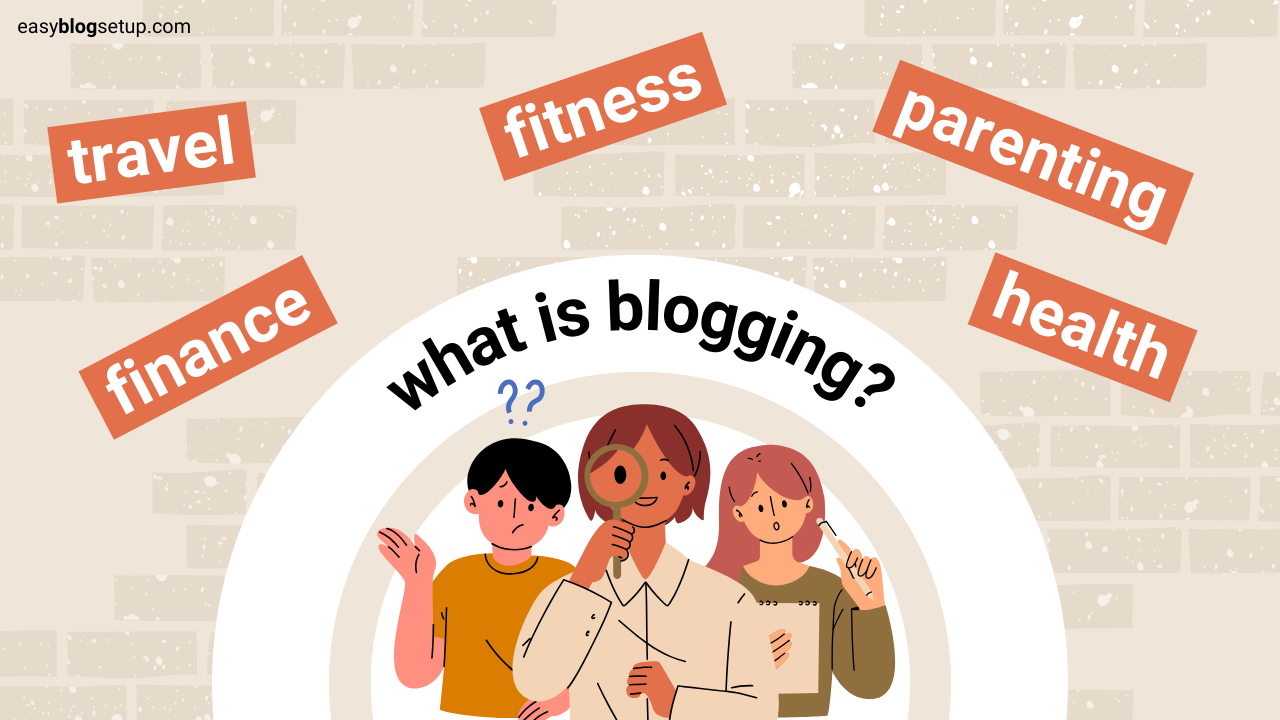
Quick Tip:
You don’t need to be a tech wizard or a best-selling author to start a blog. You just need a clear topic, a simple setup, and consistency.
Ready to build yours? Let’s move to the next level: “Why Start a Blog in 2025?”

Why Start a Blog in 2025?
(This Isn’t Just a Trend, It’s a Lifestyle Shift)
Let’s be honest…
The world is LOUD. Social media is noisy. Algorithms change every other Tuesday.
But a blog? A blog is YOURS. It’s the one place where you’re in full control.
No filters. No gatekeepers. No one telling you what you can or can’t say.
Still wondering if blogging is worth your time in 2025? Let’s get real:
Reason #1: It’s One of the Easiest Ways to Make Passive Income
Yup. While most side hustles require clocking in hours for every dollar earned…
Blogging lets you write once and earn forever.
One good post can pay you for months, even years.
Reason #2: You Build a Personal Brand That Actually Matters
People don’t just buy products, they buy trust.
Your blog becomes your credibility engine. Whether you want to:
- Start freelancing
- Launch a coaching business
- Sell a course
- Or even get a book deal…
Your blog builds the audience that builds your career.
Reason #3: You Can Blog From Literally Anywhere
Coffee shop? Yes. Beach in Bali? Absolutely.
Your blog doesn’t care where you are it only cares that you show up.
(And once it’s running, even that becomes optional.)
Reason #4: You Own It
Social platforms are rented space.
Your blog is your real estate on the internet. You control the:
- Design
- Message
- Monetization
And best of all? No one can ban or block you from your own website.
Blogging in 2025 = Modern-Day Digital Freedom
Think about it:
Would you rather scroll endlessly through content you don’t care about…
Or create content that actually earns you money, fans, and freedom?
You’re not too late. You’re right on time.
Mini Case Study
Sara was a mom of 2, working a 9–5 job she hated. In 2023, she started a blog about meal prepping and parenting hacks. By 2024, she was earning over $3K/month through affiliate products and digital downloads, all from her kitchen table.
You Don’t Need to Be a Pro. You Just Need to Start.
Every pro blogger started as a beginner probably Googling “how to start a blog” just like you.
And now? It’s your turn.

Let’s Get Started: The Simple Path to Launching Your Blog (In Less Than 1 Day)
You don’t need to be tech-savvy. You don’t need to be a coder.
You just need a plan and lucky for you, I’ve already built it.
Here’s the big truth:
Most people don’t start a blog because they think it’s complicated.
But once you know the steps, it’s like following a recipe and spoiler: this one’s delicious.
Warning: Perfectionism Will Try to Stop You
Don’t fall for it. Your blog doesn’t need to be perfect. It just needs to exist. You’ll improve along the way, that’s the secret of every successful blogger.
The “Easy Blog Setup” 7-Step Framework
This isn’t just a list. This is your action map.
We’ll dive into the details of each step in the next sections, but here’s the bird’s eye view:
Step 1: Pick a Blog Topic That Actually Excites You
Step 2: Choose a Blog Name That Sticks
Step 3: Get Your Blog Online (Domain + Hosting)
Step 4: Set Up Your Blog with WordPress
Step 5: Customize the Look & Feel
Step 6: Write and Publish Your First Blog Post
Step 7: Promote It and Start Growing
Quick Tip:
If you’re reading this and feeling a bit overwhelmed > good. That means you care. But I’ve got you. We’re going to do this together, one step at a time.

Choosing a Blog Name & Topic (This is Where Your Blog is Born)
You ever try naming a pet and end up 40 minutes deep into name generators and Instagram polls?
Yeah. Picking your blog name can feel the same exciting but slightly overwhelming.
But don’t worry I’m not just giving you tips. I’m giving you the exact formula.
First, Let’s Talk About Your Blog Topic (aka: Your Niche)
Your blog needs a focus, a topic that makes people say, “Omg, that’s exactly what I needed!”
Here’s how to find the right topic for YOU:
Ask Yourself:
- What do I LOVE talking about nonstop?
- What do people often ask me advice on?
- What’s something I’ve learned the hard way (and now want to help others with)?
- What do I spend hours researching for fun?
3 Golden Rules for Picking a Blog Topic:
- You genuinely care about it. Because you’ll be writing about it… a lot.
- There’s an audience for it. Use Google, Reddit, Facebook groups. Are people already asking questions about this? That’s a good sign.
- It can be monetized. You can sell affiliate products, services, courses, or get sponsorships in this space.

Examples of Great Blog Topics (in 2025):
- Personal finance for Gen Z
- Healthy recipes for busy parents
- Sustainable fashion on a budget
- Fitness for new moms
- Remote work life hacks
- AI tools for small businesses
- Mental health for teens
- Travel guides for solo female travelers
Now… Let’s Name That Blog
Your blog name should be:
- Memorable
- Simple to spell
- Brandable
- Relevant to your topic
Name Formulas That Work:
- [Your Name] + Blog/Space/Journey
e.g., JessicaWrites, Mike’s Money Journey
- Descriptive + Benefit
e.g., FitAndThriving, BudgetBites, MindfulExplorer
- Playful Words or Rhymes
e.g., HustleNest, SnugBites, ZenDen
- Niche Specific
e.g., CryptoChick, PlantParenthood, SideHustleScript
Pro Tips:
✅ Check domain availability right away (we’ll guide you in the next section).
✅ Stick to (.com) if possible.
✅ Avoid numbers or hyphens.
✅ Say it out loud, does it sound right?
Bonus Tool You Can Use:
Try free name generators like:
- namelix.com
- lean domain search
…just don’t get stuck scrolling for hours. Keep it fun, fast, and flexible.

Getting Your Blog Online (Domain + Hosting Made Easy)
Okay, your idea’s solid. Your name is picked.
Now let’s make it real, let’s launch your blog on the internet.
But wait… what does that actually mean?
Let’s break it down in the easiest way possible.
What’s a Domain Name?
Your domain is your blog’s address on the internet.
For example:
- www.easyblogsetup.com is a domain
- So is mycoolblog.com
It’s what people will type to find you.
Tips:
- Keep it short, sweet, and easy to spell
- Always go for (.com) if available
- Try to include your main keyword (like fitness, budget, mom, travel, etc.)
What’s Hosting?
Your hosting is like the land where your blog lives.
Without hosting, your blog is just floating in space invisible to the world.
It stores all your:
- Posts
- Images
- Pages
- Site files
Think of hosting as the engine under the hood of your blog.
How to Get Both in One Go (The Easy Way)
You don’t have to buy a domain and hosting separately.
You can get everything set up in minutes using the hosting provider I recommend.
HOSTINGER (BEST SUPER FAST HOSTING WITH 90% OFF DISCOUNT)
Plans to Choose (Keep it Simple):
When signing up for hosting, you’ll usually see 3–4 plans.
Here’s how to decide:
Click here to visit the Hostinger Hosting Page & Click on “Start Now” button

Selecting your plan: We recommend the Premium plan who’re starting new business.


And lot more features…
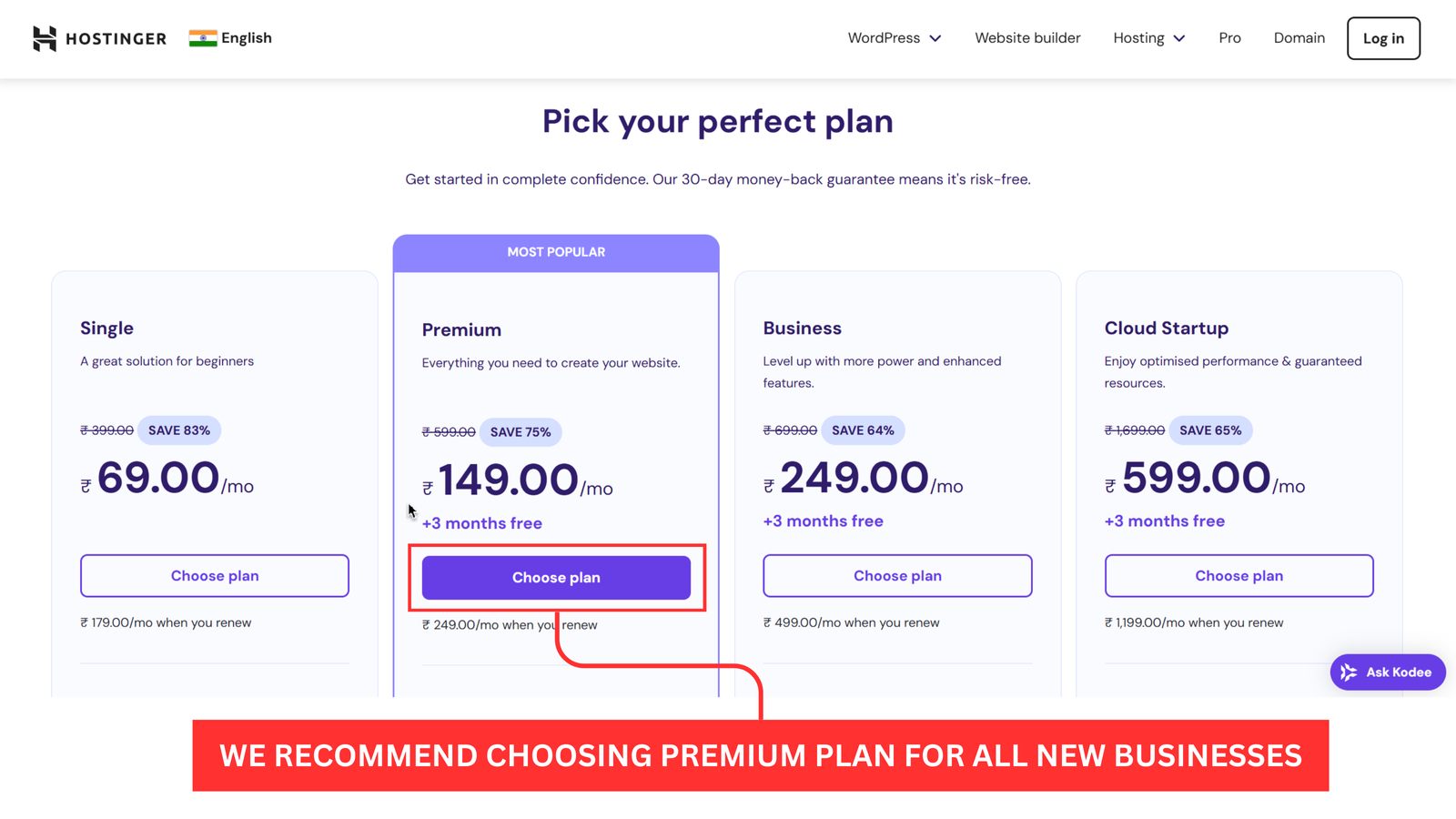
- We recommend choosing hosting period to be 12 or more than 12 months. There’re multiple reasons like higher hosting monthly fee + not getting extra FREE hosting months offer.
- You can enter coupon “EXTRA10” code for extra 7% Discount 🎉
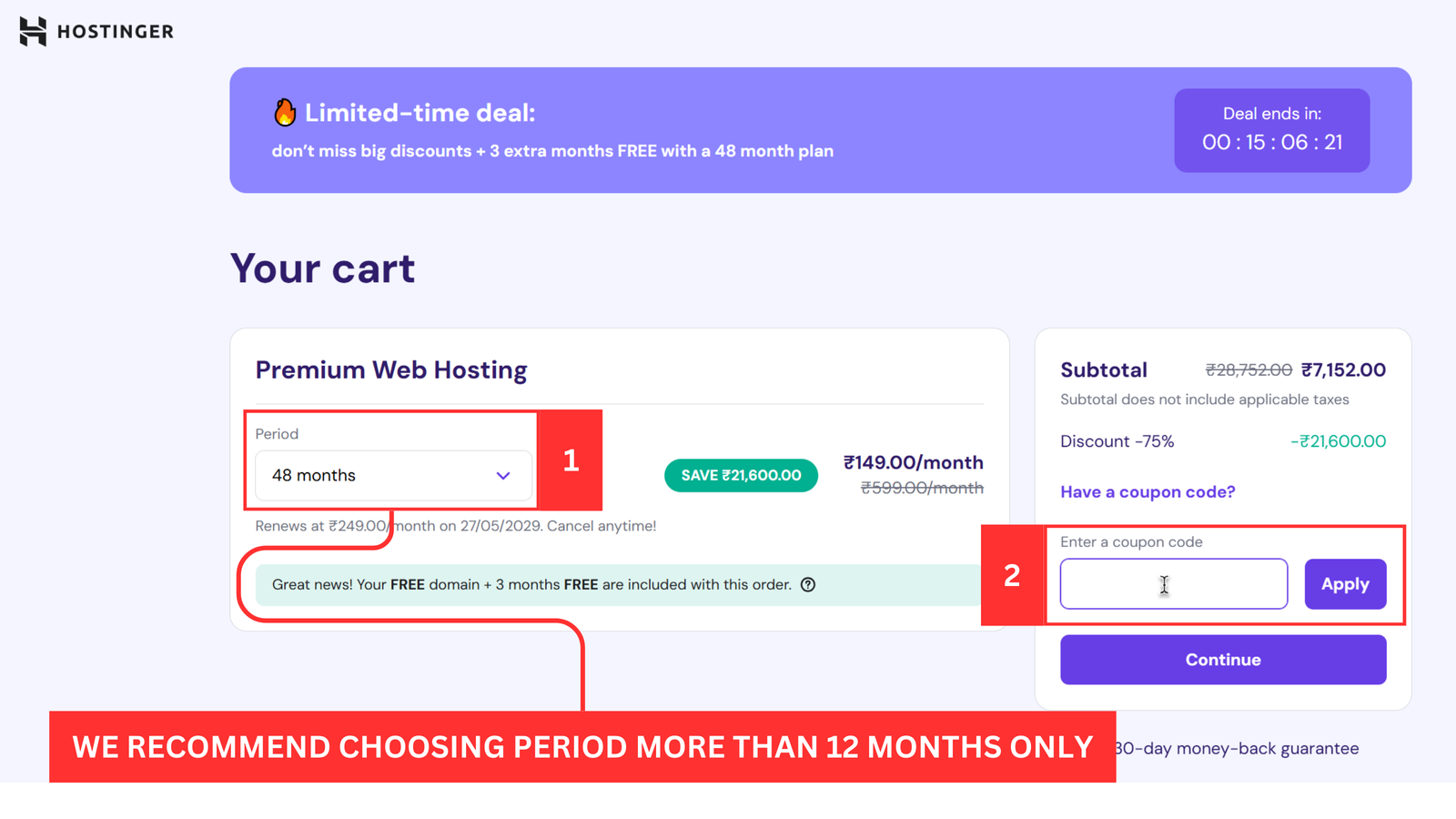
Now create your account by adding your email & strong password.
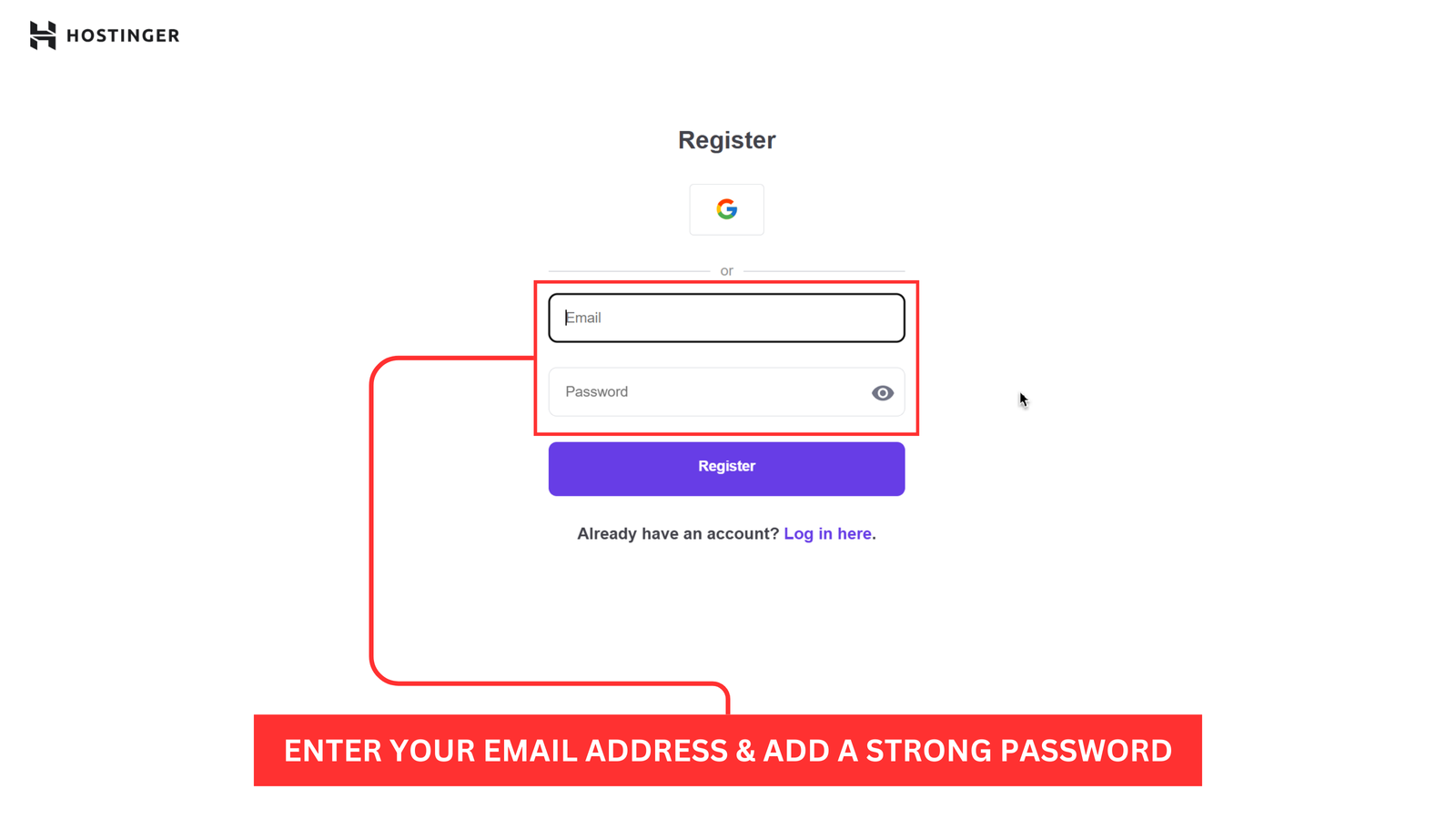
Now, enter your billing address and proceed with payment.
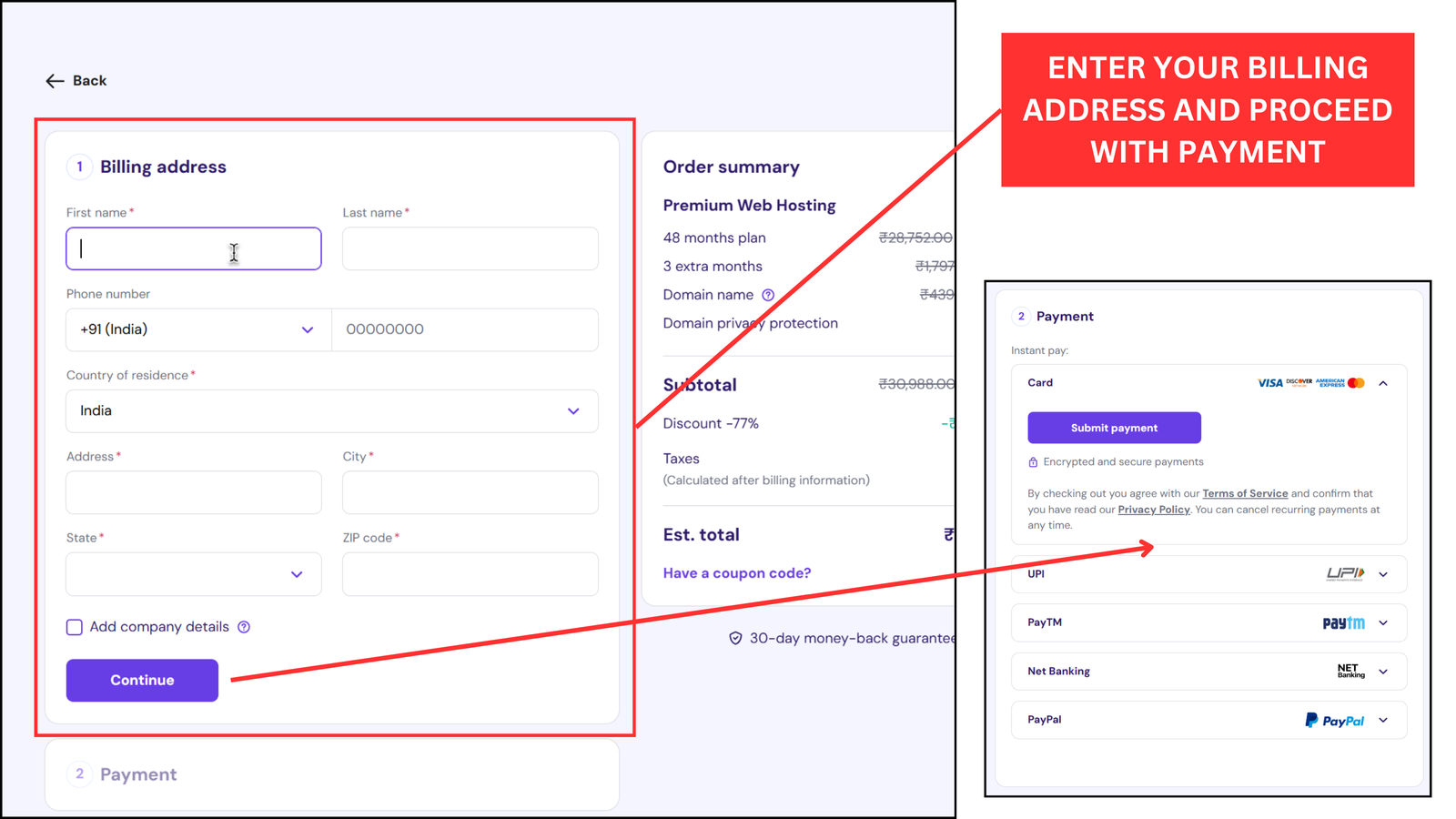
After making your payment you’ll be redirected to your Hostinger homepage.
Here you can click “Claim domain” button to claim your free domain name.
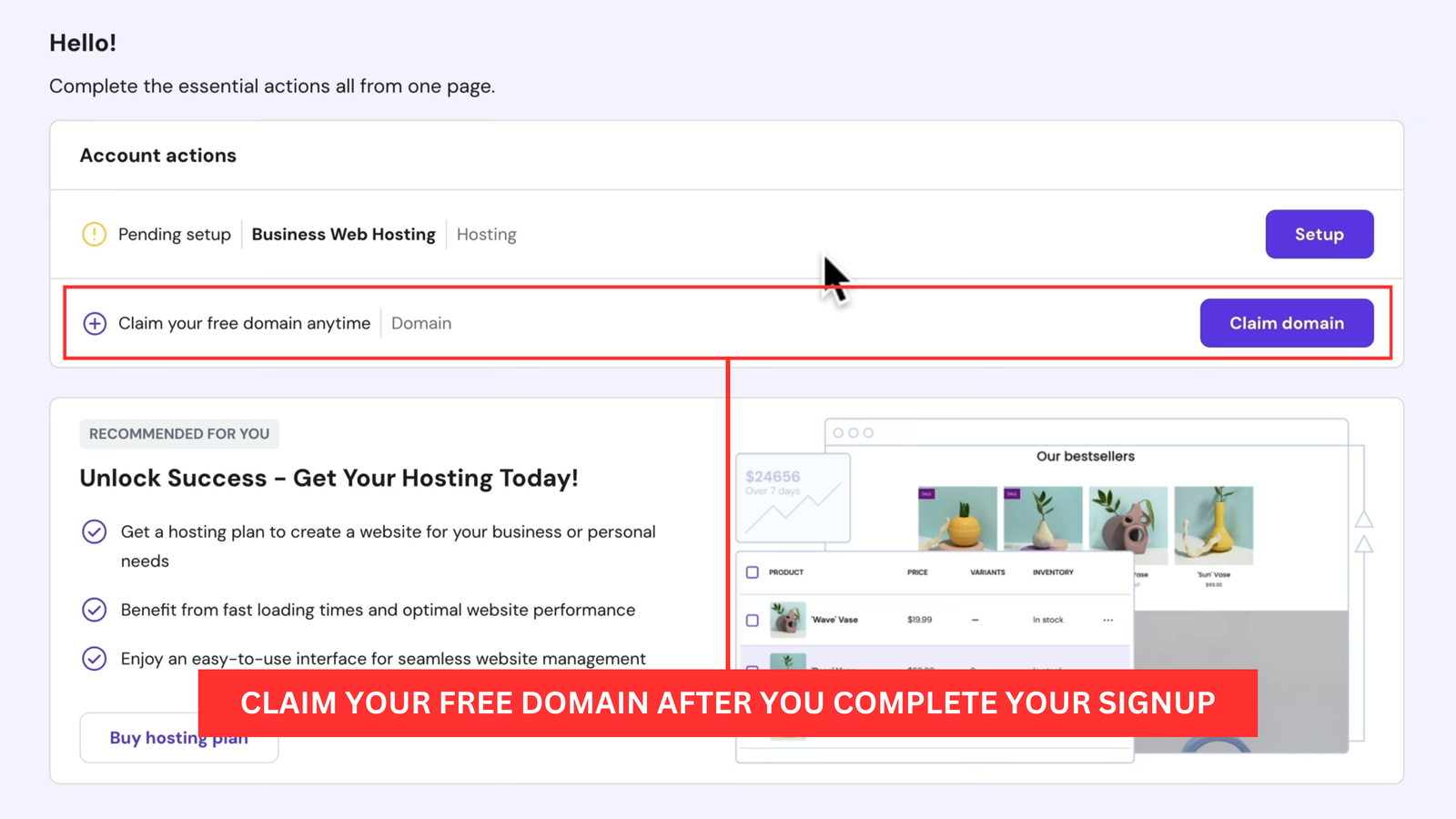
- Find your business name availability. We already discussed in Level 4 on how to find best business name for your blog.
- After selecting your perfect blog name click “Claim Domain” button, we recommend selecting (.com) domains.
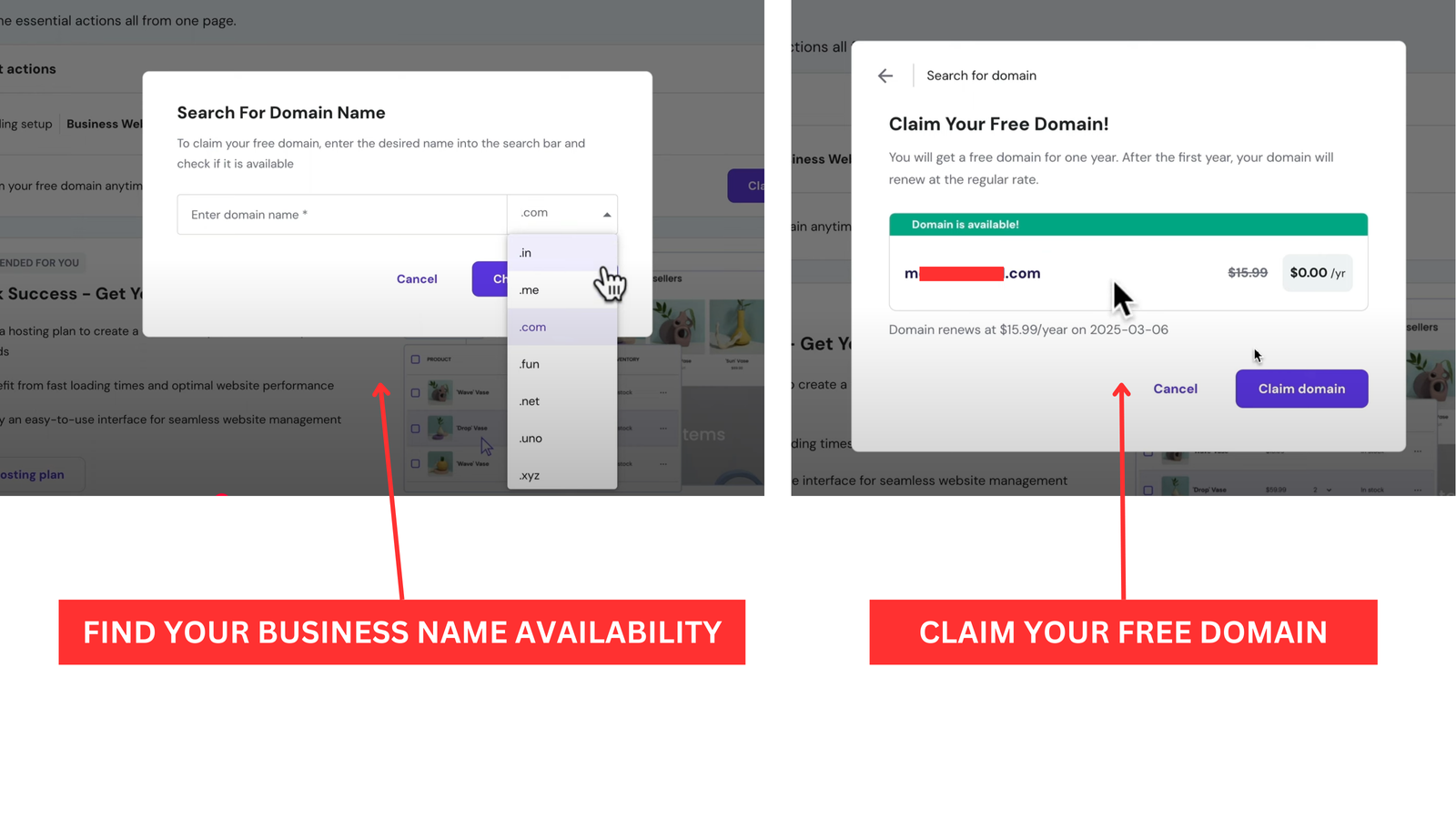
Congrats 
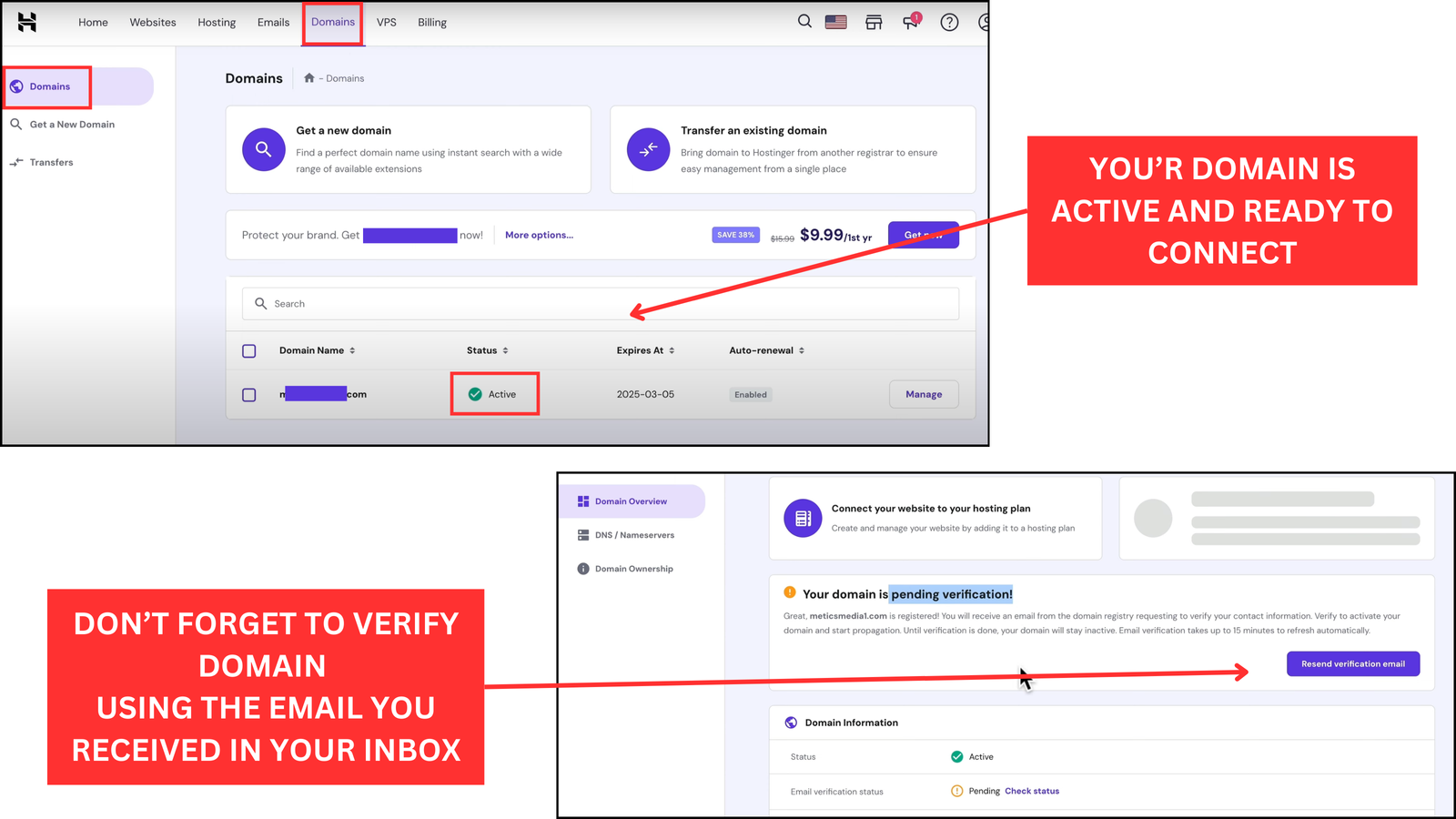
Congrats 

Blog Installation & Initial Setup (No Tech Headaches, Just Clicks)
So you’ve got your domain + hosting. Now it’s time to install WordPress: the platform that powers over 40% of the internet.
If websites were houses, WordPress would be the walls, doors, rooms, furniture everything you see and use.
And guess what?
You don’t need to code anything.
Installing WordPress is literally… a click. One. Click.
Step-by-Step: Installing WordPress
Step 1: Log into Your Hosting Dashboard
You’ll land on your control panel (usually called “cPanel” or “Dashboard”).
Step 2: Find “Install WordPress”
You’ll see a WordPress logo or a section then click on button “Add Website” and choose WordPress.
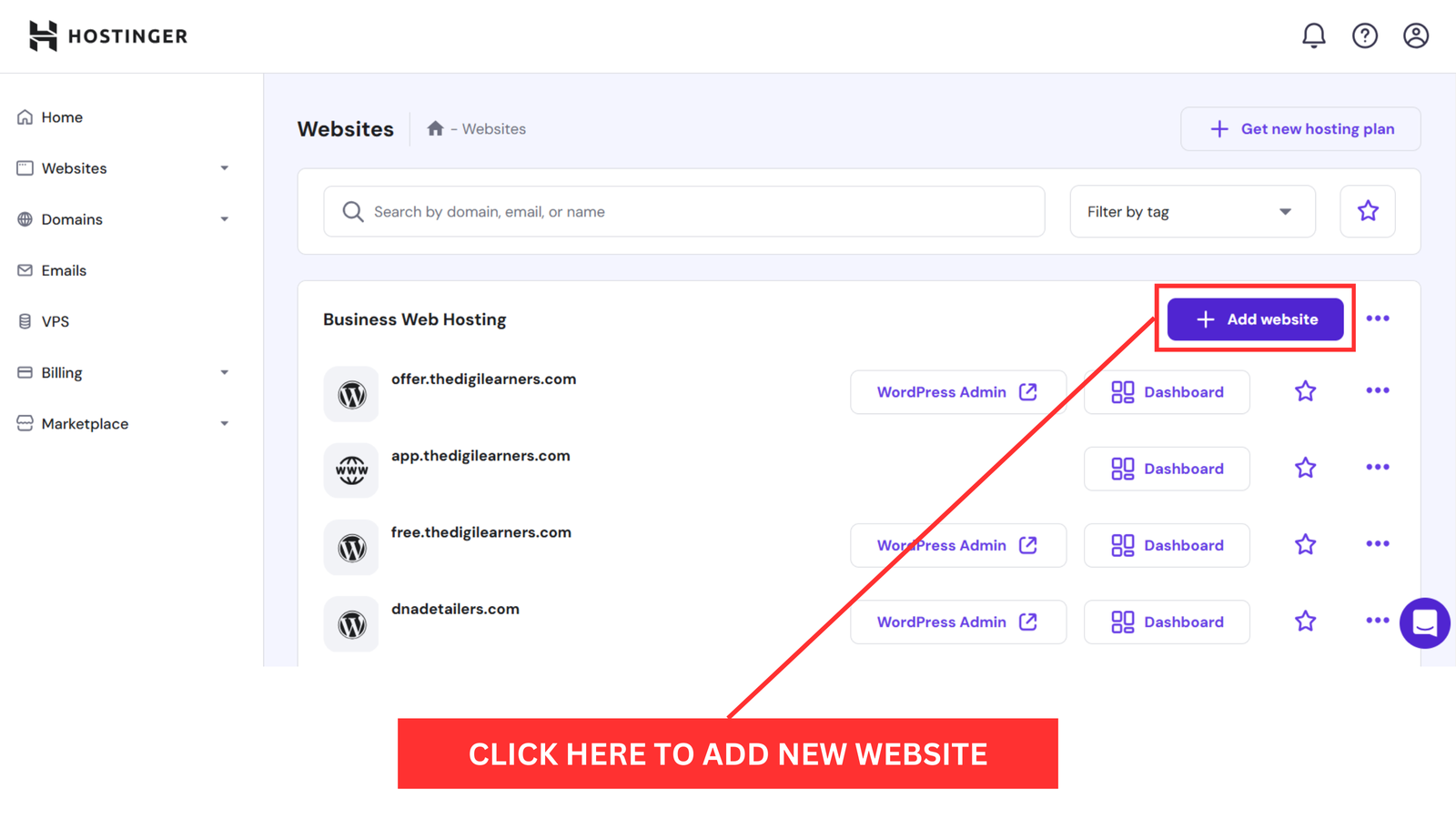
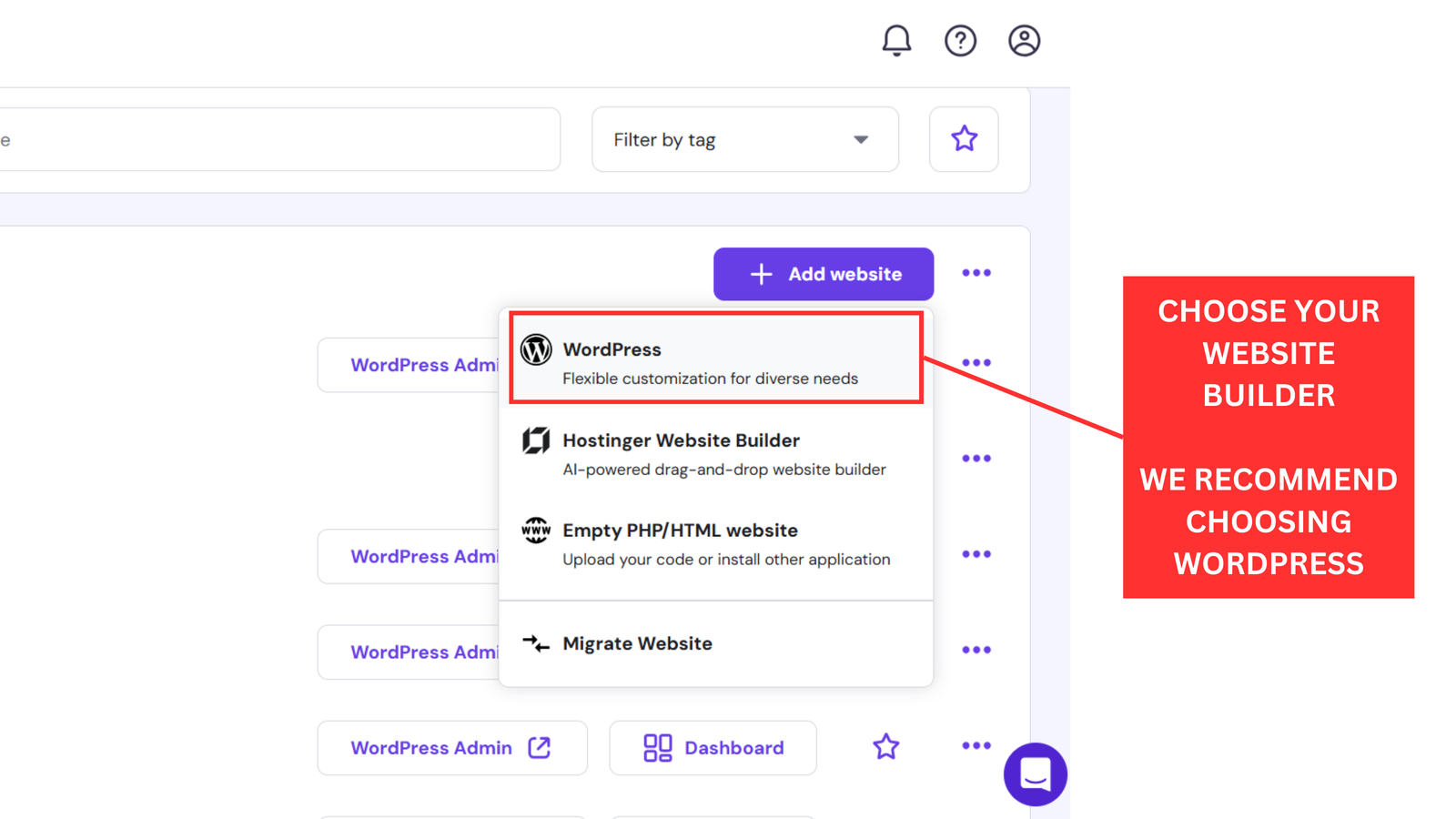
Now enter your email & password. These will be your website credentials you’ll use these to login to your blog every time.

Now there will be options to build your website using AI builder, Pre-build themes or creating blank site. We recommend choosing “Create blank site” We’ll discuss this part in later sections.
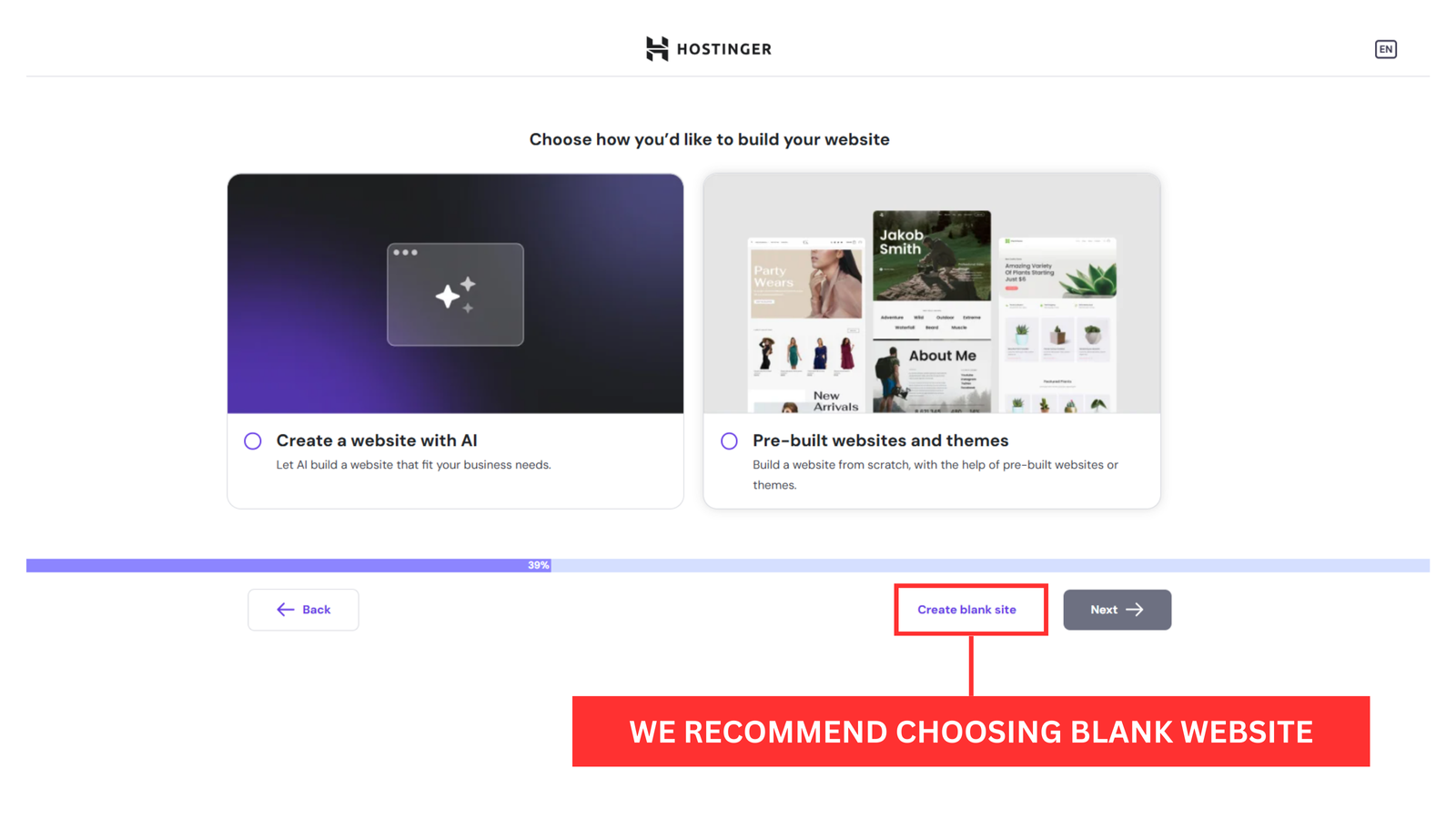
After clicking next enter your domain name here, now there are two scenarios:
- You claimed the domain using Hostinger: You don’t have to worry just enter your domain and it will connect automatically. (You can click here to skip this part if you connected your domain using Hostinger claimed domain only)
- You already bought your domain using other service provider like Namecheap or GoDaddy: Now we’ve to change DNS records to connect domain to Hostinger. (5min. Task)

Tip: If you’re confused click on “Use Temporary Domain” feature & Hostinger will provide you with temporary domain which you can change later.
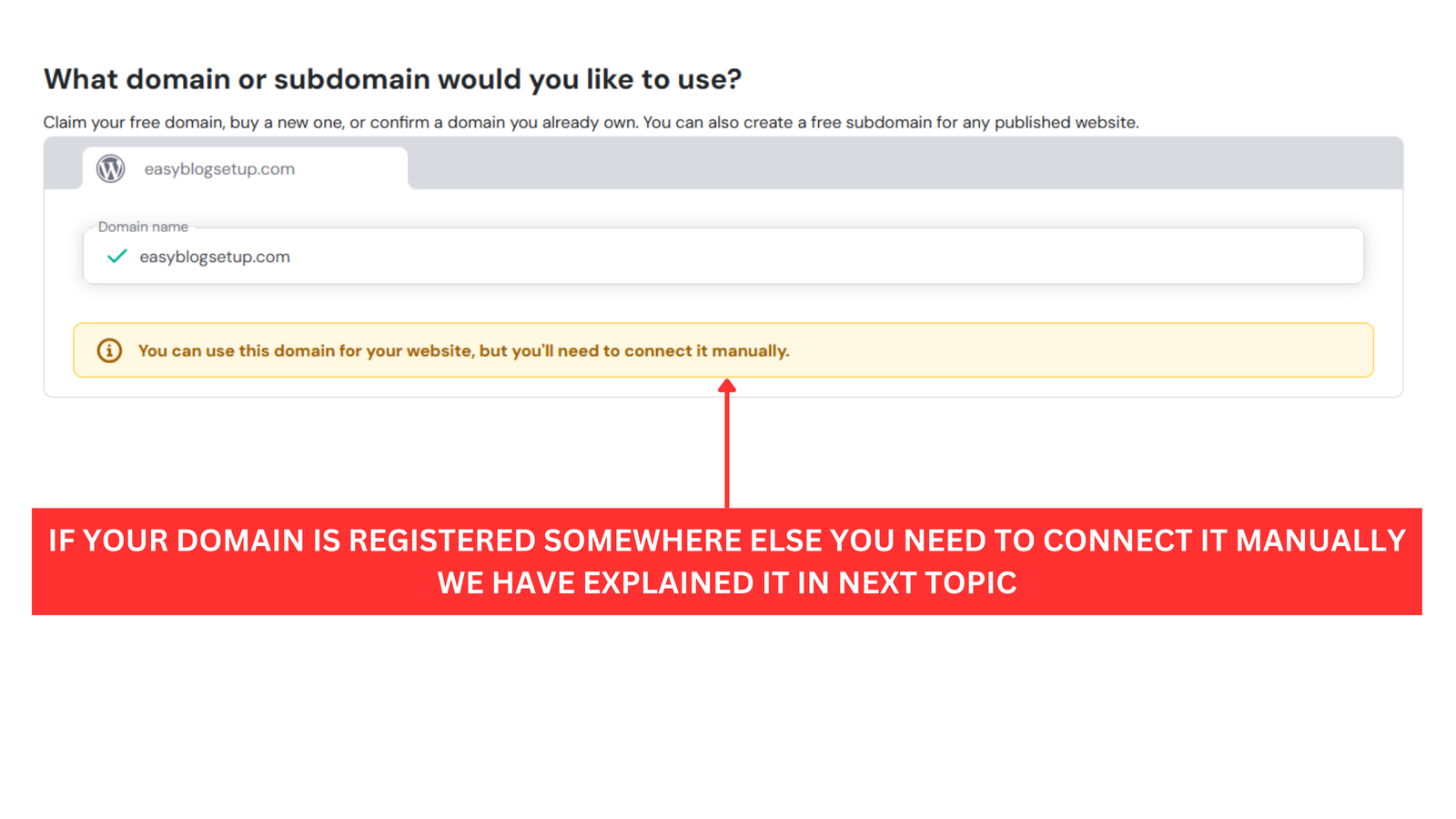
After proceeding WordPress will started installing & will be installed within next 1-2 min only.
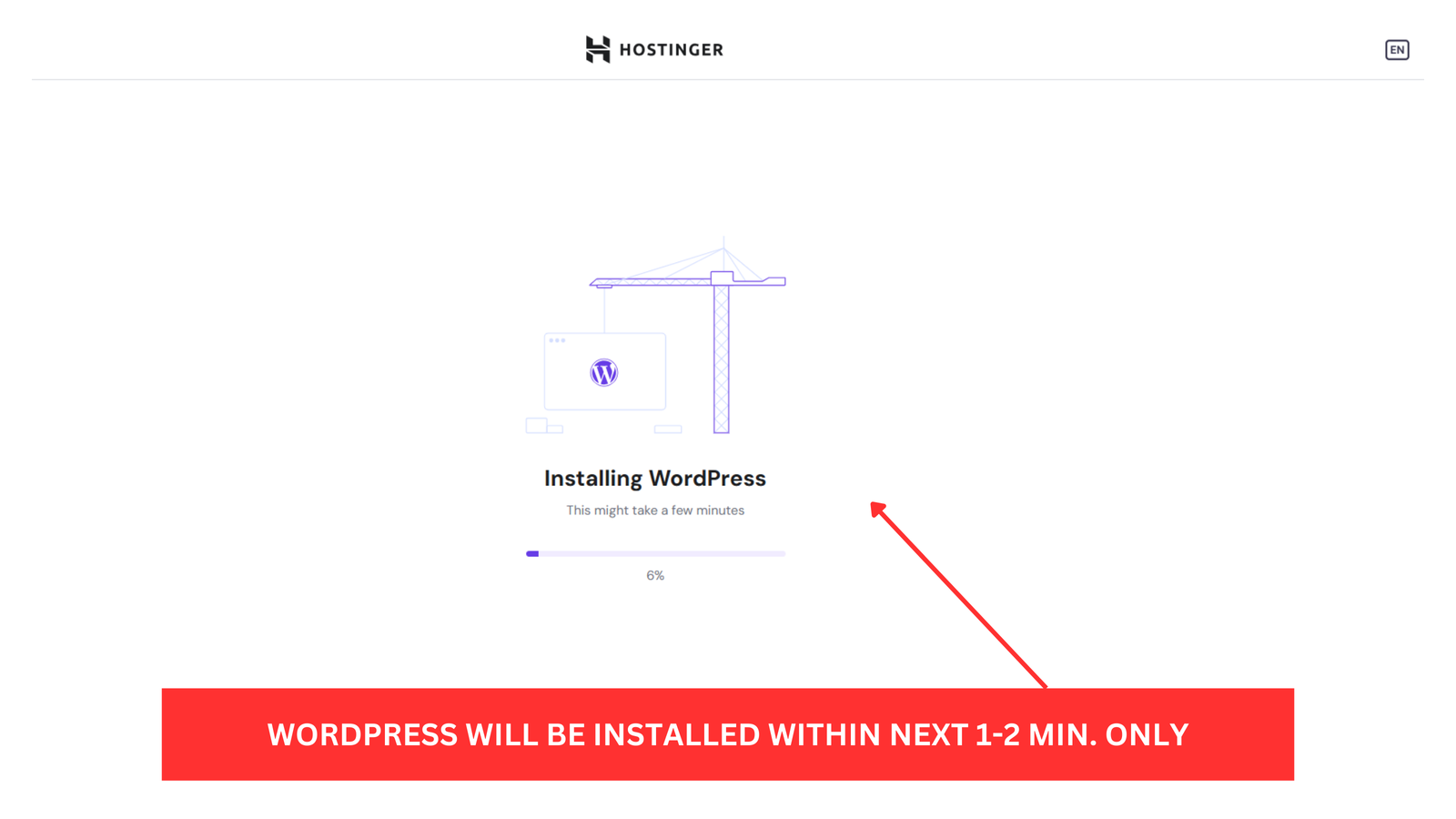
Congrats 🎉 Your WordPress website is ready.
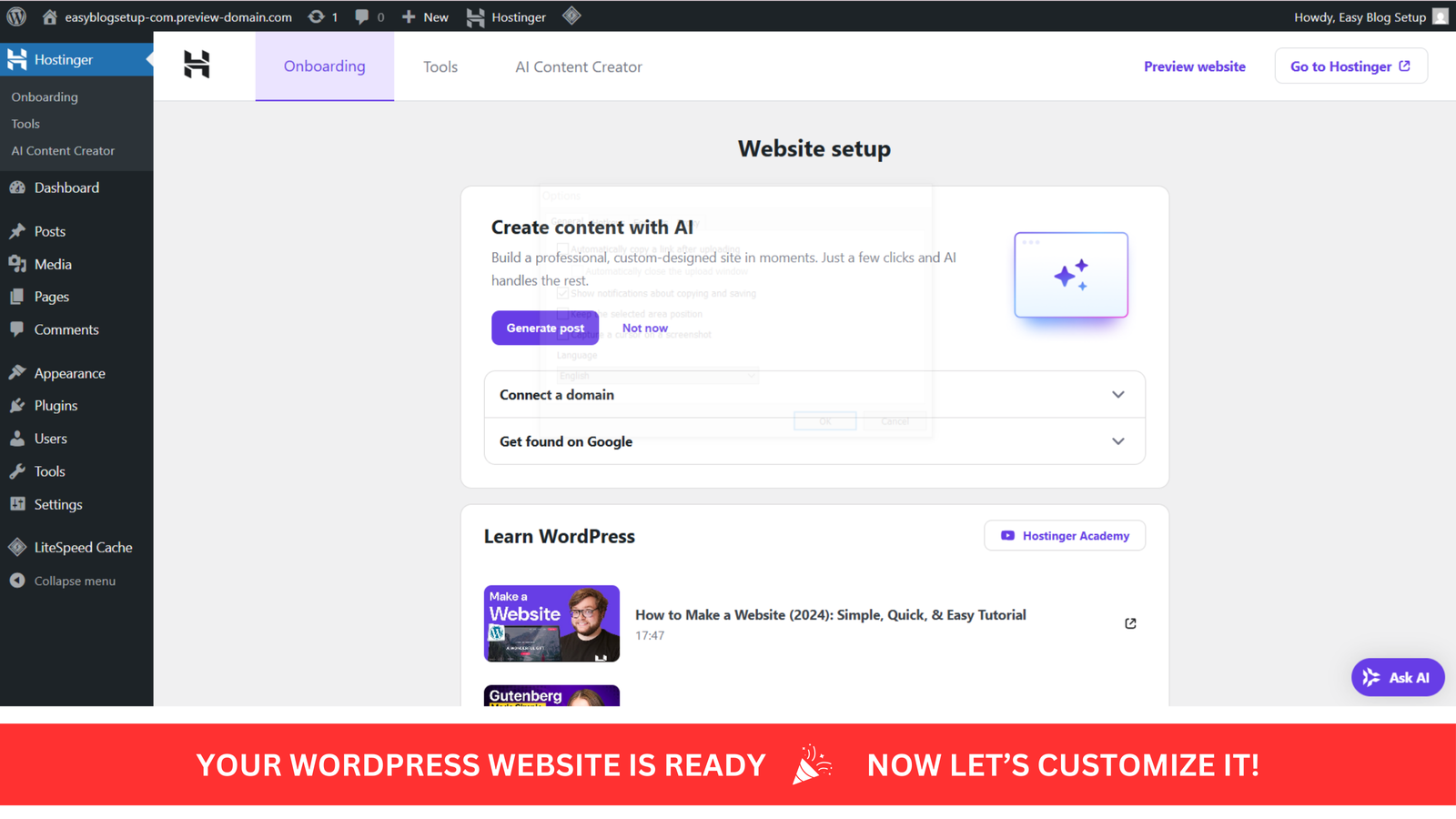
Before proceeding to customization part, if you’ve selected temporary domain option here are few steps to connect your domain to Hostinger 👇
For those who already purchased their domain from Namecheap. Easy steps below:
1. Click hPanel – Websites from the dashboard or just go back to your main Hostinger dashboard.

2. Now click on the “Dashboard” button from Websites tab.
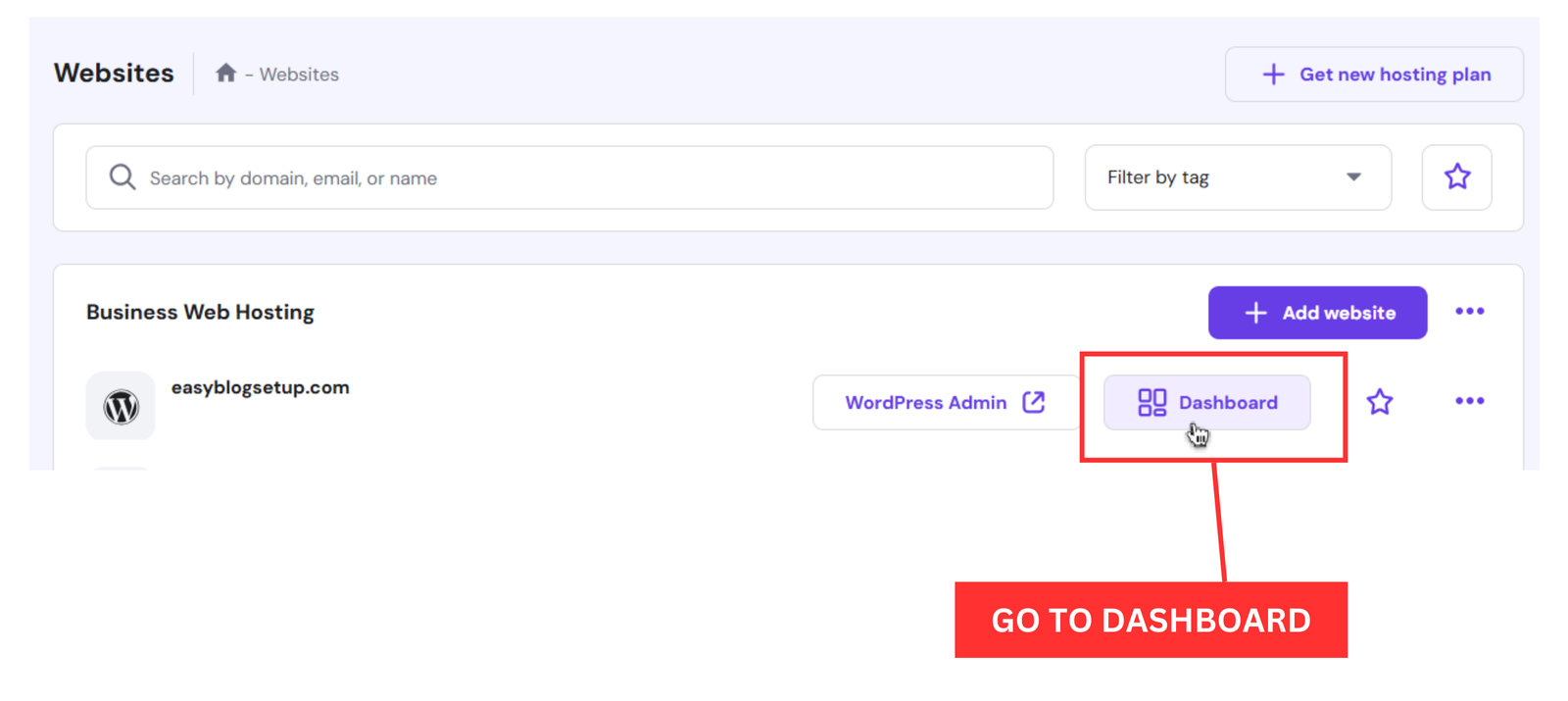
3. Now click on “Check guide” button
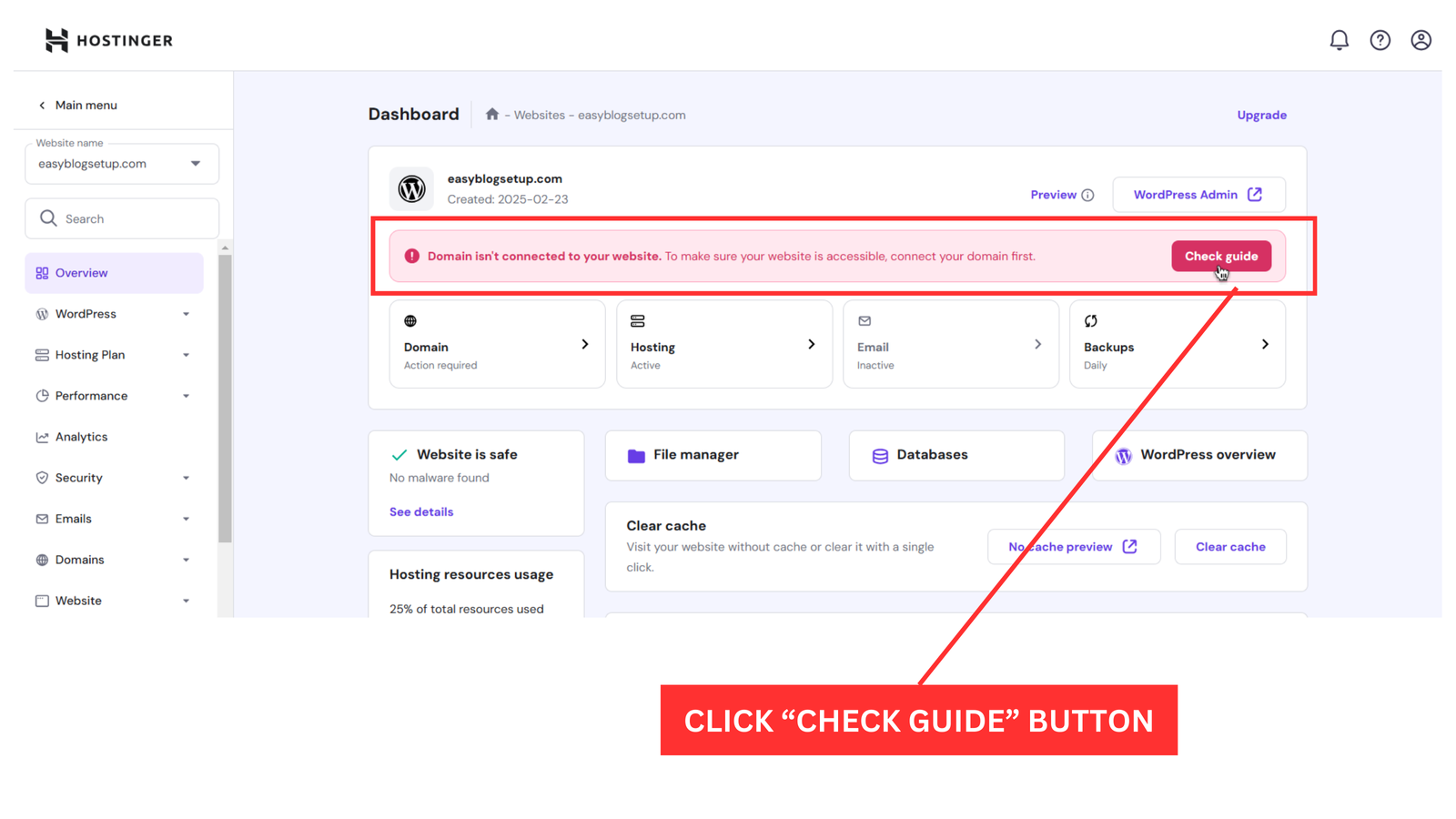
3. Copy these nameserver records and login to your Namecheap account.
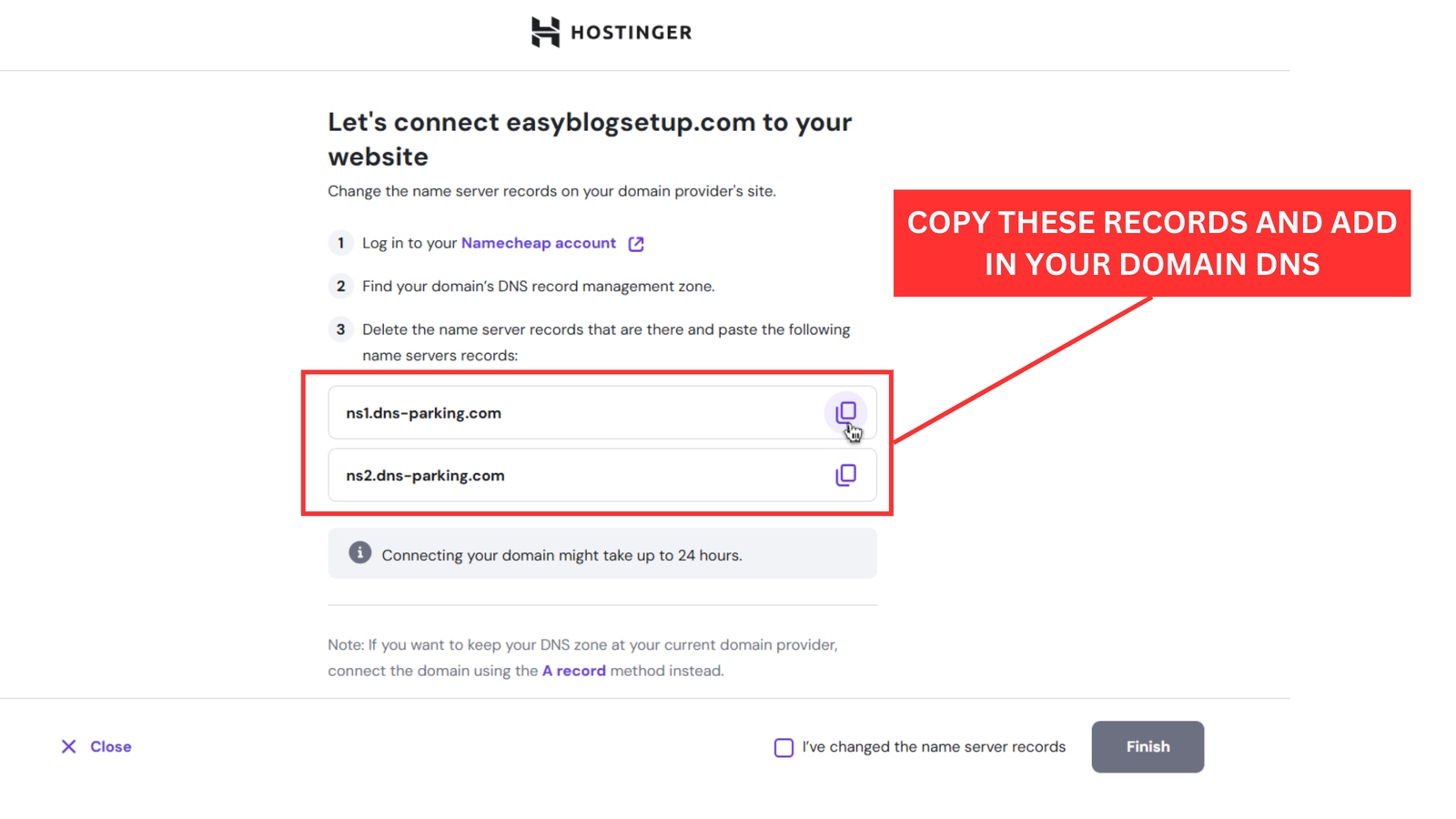
4. Now open domain tab in your Namecheap account and you’ll find NAMESERVERS option > Click and select “Custom DNS” option from the list.

5. Now add copied nameservers and click “Save” Usually it takes 5-10 min. to get added. (It may take more time)

6. Now click on “Finish button” and nameservers will be updated automatically within next few 5-10min. or may take more time.
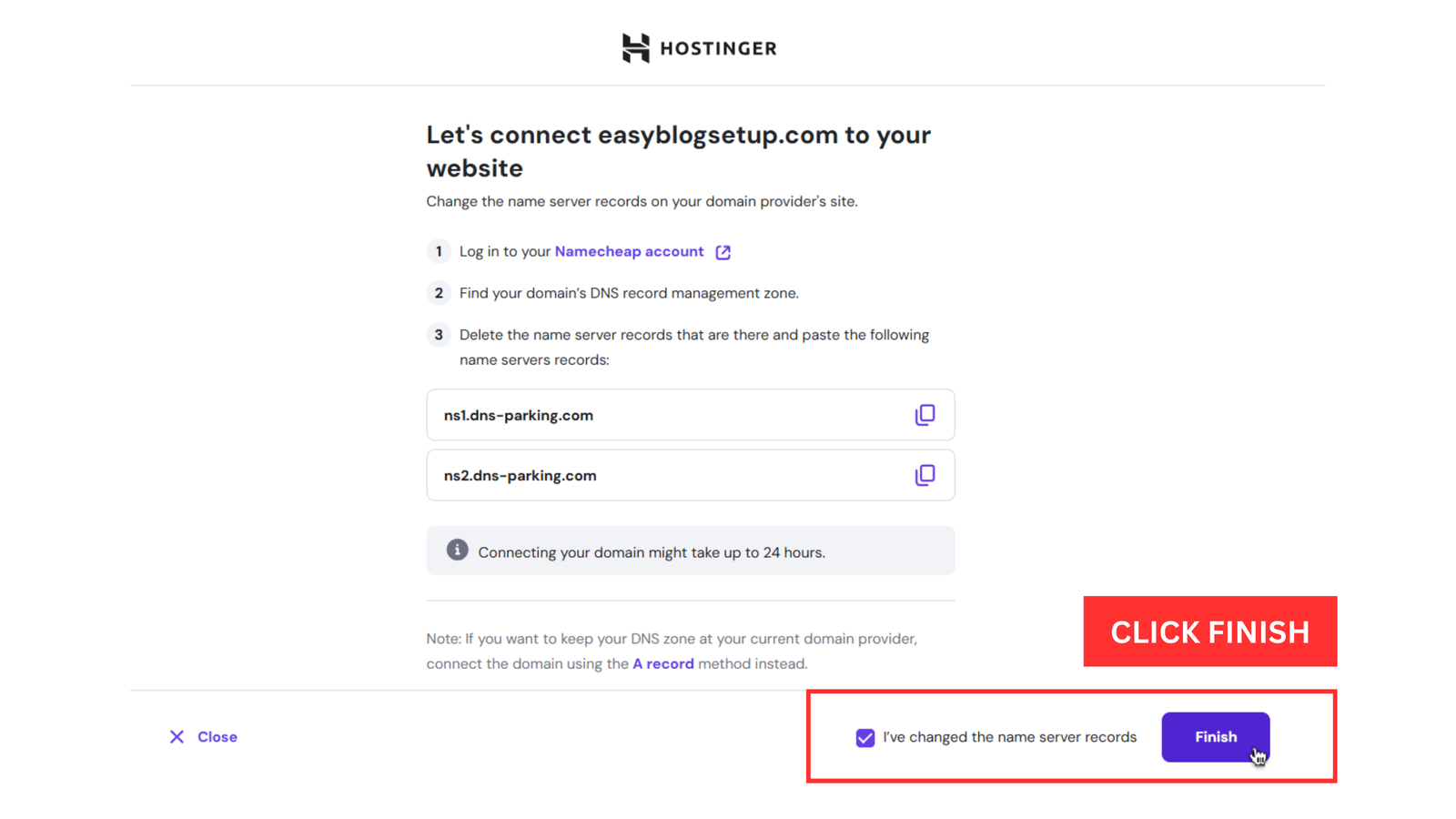

We’ll be adding steps here asap. If you’re facing any issue please contact us & our team will help you setup you Hostinger <> WordPress account for FREE. Contact Us
Even after adding domain correctly, sometime users face “Connection not secure” issue on their SSL. Here’s how you can fix this in easy simple steps 👇

Even after adding domain correctly, sometime users face “Connection not secure” issue on their SSL. Here’s how you can fix this in easy simple steps 👇

Follow these steps to reconnect your SSL:
- Click on SSL button from Security tab
- After opening SSL certificate click the button “Cancel”
- Then click “Install SSL” to reinstall the SSL certificate again
- Done! Your SSL is reinstalled and connected securely.
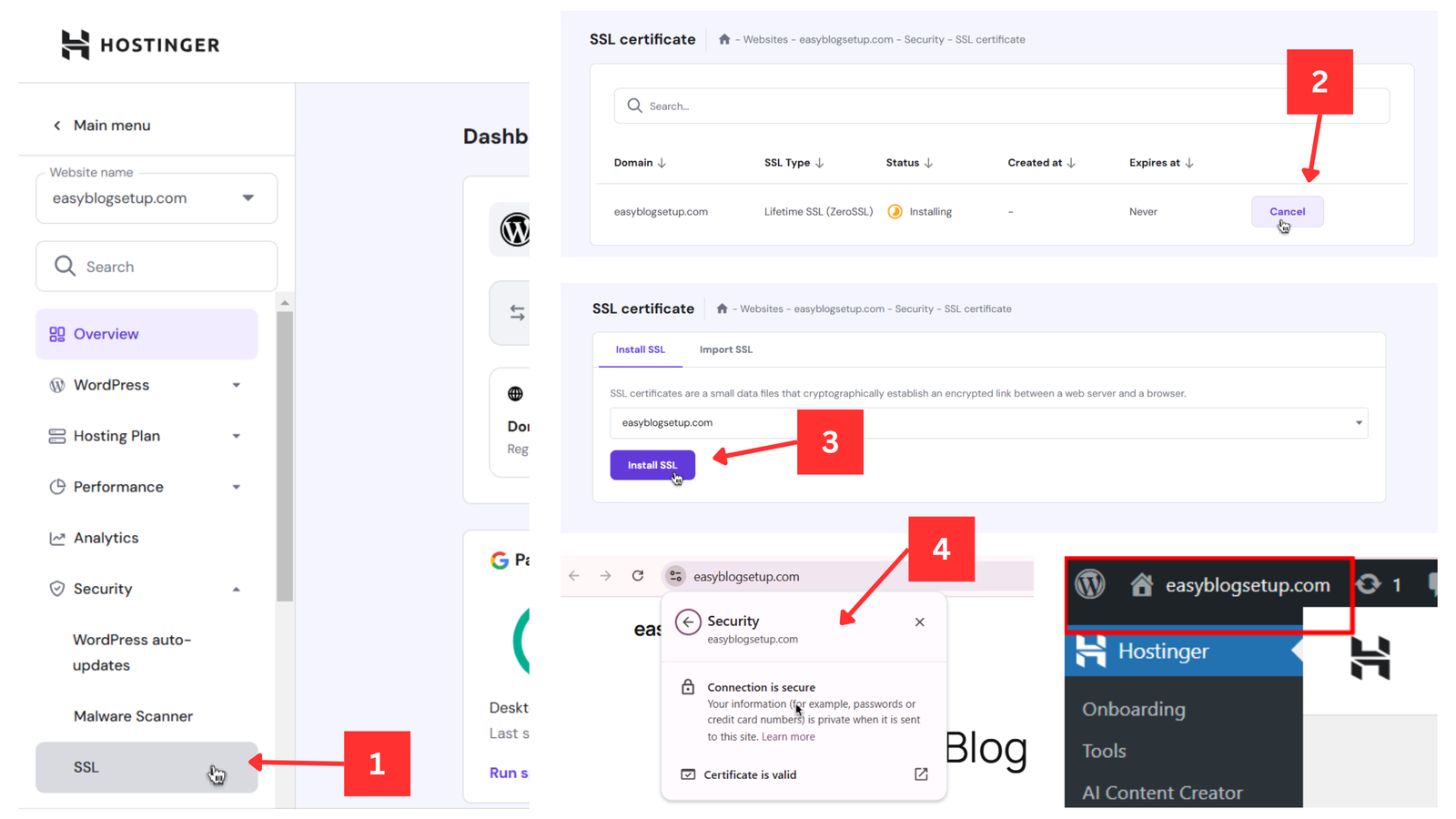
Pro Tip: How to login to your website (blog) dashboard?
You don't have to login Hostinger every time to login into your WordPress dashboard. You can simple visit: www.yourblogname.com/wp-admin
Just after your website domain add (/wp-admin) & dashboard will open, you just need to add your WordPress Id/Password to login.

Customizing Your Blog (Make It Look Like Your Brand)
Right now, your blog is live… but it probably looks like a generic demo site.
No worries! now we’re going to turn it into a branded, beautiful space that reflects YOU and your niche.
Step 1: Choose a Theme (This is Your Blog’s Outfit)
A theme controls how your blog looks layout, fonts, colors, everything.
How to Pick the Right Theme:
- Lightweight & fast-loading
- Mobile responsive
- Customizable
- Easy to use (especially for beginners)

How to Install a WordPress Theme:
Step-by-Step:
- Go to your WordPress dashboard
- Click Appearance > Themes
- Click “Add New”
- Use the search bar (type “Astra” or “GeneratePress”)
- Click Install, then Activate
Done!
You can also upload themes by clicking “Upload Theme” button.
Note: Themes are uploaded in ZIP format only.
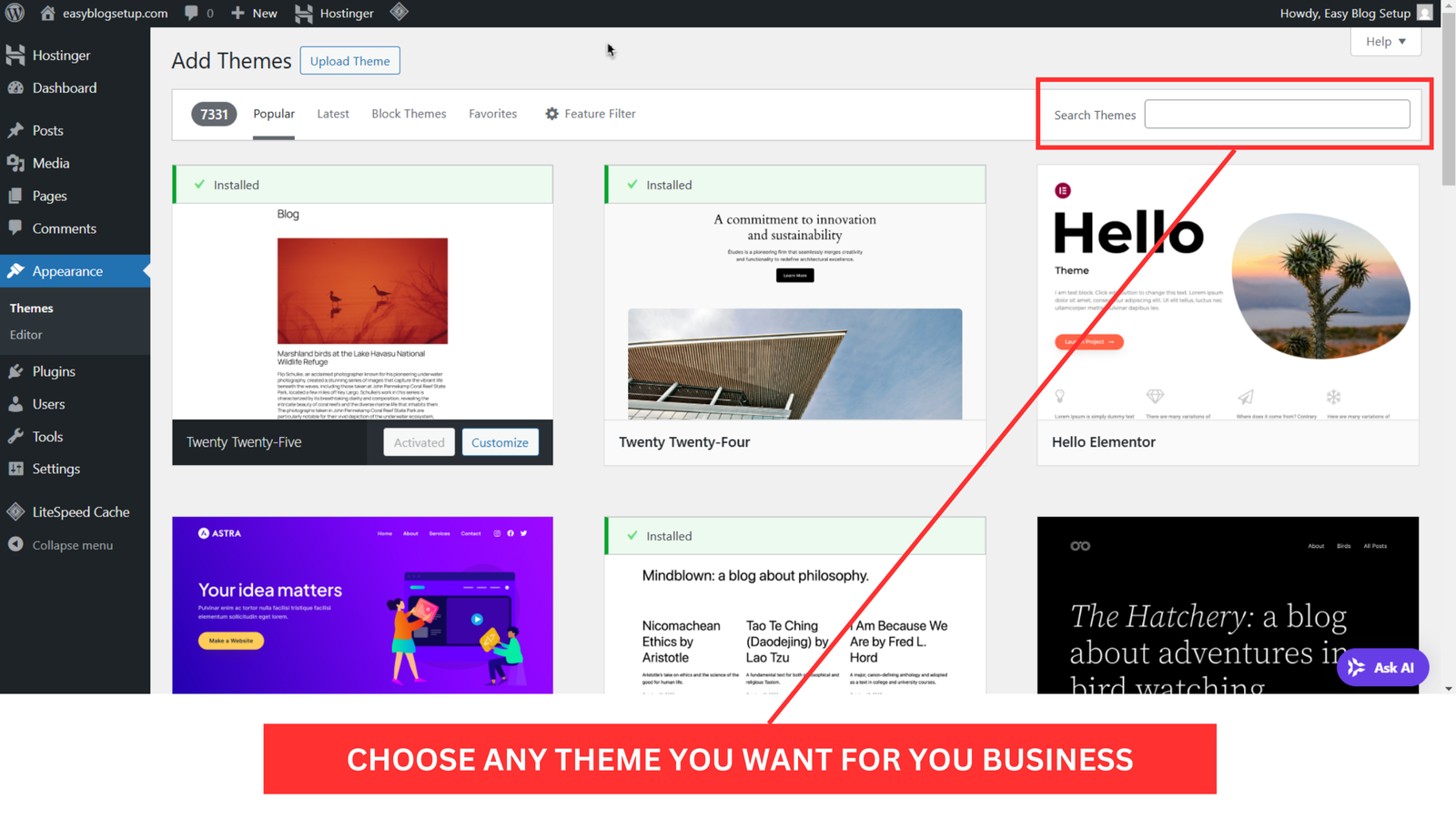
Recommended Free WordPress Themes:
- Astra – Super fast, customizable
- GeneratePress – Clean, minimal, and great for SEO
- Kadence – Gorgeous and beginner-friendly
- Neve – Lightweight and flexible
Want premium (paid) themes?
Try:
- Divi – Drag-and-drop builder included
- Thrive Themes – Great for marketing & conversions
- Elegant Themes – Premium design without coding
Step 2: Customize Your Site’s Look
Once the theme is activated:
- Go to Appearance > Customize
Here you can edit:
- Site Title and Tagline
- Logo (upload your brand image)
- Colors
- Fonts
- Layouts
- Header/Footer
- Menus
Pro Design Tips (No Design Degree Required):
- Use 2–3 main brand colors
- Pick 1–2 easy-to-read fonts (Google Fonts are built-in)
- White space is your friend — clean looks more professional
- Don’t clutter your homepage — keep it simple, intentional, and easy to navigate

Step 3: Install a Few Must-Have Plugins
Plugins = apps for your blog.
Here are 5 to start with:
- Yoast SEO: Helps with search engine optimization
- WPForms: Add contact forms easily
- UpdraftPlus: Backup your site (just in case!)
- SiteGround Optimizer or WP Rocket: For speed & performance
- Pretty Links: Manage affiliate links cleanly
Go to Plugins > Add New, search for them, click Install, then Activate.
Pro Tip:
Blogs that load in under 3 seconds get better rankings and lower bounce rates, so keep your theme fast and your plugin list minimal.
Start with just one homepage layout. Don’t worry about perfection. You’ll tweak it as you grow.

Writing & Publishing Your First Blog Post (Your Voice. Your Story. Your Power)
Let’s get this straight:
You don’t need to be a “writer” to blog.
You just need to help someone, teach something, share your story, or solve a problem.
That’s it.
What Should Your First Post Be About?
Some ideas to kick it off:
- “Why I Started This Blog” – tell your origin story
- “Beginner’s Guide to [Your Topic]”
- “Top 5 Mistakes I Made in [Your Journey]”
- “My Favorite Tools/Books/Resources for [Your Niche]”
- A ‘how-to’ that solves one small but specific problem
How to Write a Blog Post in WordPress (Step-by-Step)
Step 0: Go to Your Dashboard > Posts > Add New
You’ll land on the WordPress block editor.

Step 1: Add a Blog Title
Make it:
- Clear
- Intriguing
- Benefit-driven
- (e.g., “How I Paid Off $10K Debt in 10 Months – My Step-by-Step Plan”)
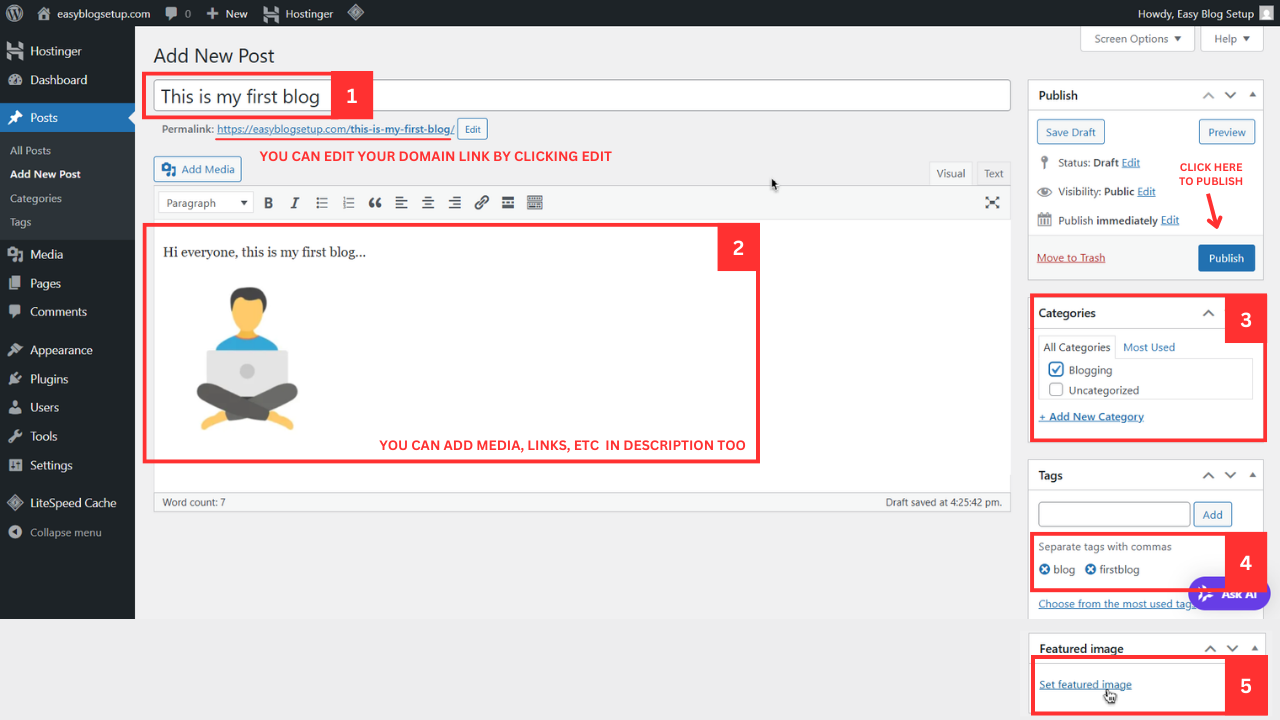
Step 2: Start Writing in Blocks
Each paragraph, image, list, quote = a block. Super simple.
You can also:
- Add headings (H2, H3) to break up sections
- Add bullet points, numbered lists, bold quotes
- Embed YouTube videos, Tweets, etc.
Step 3: Assign a Category
Choose a relevant blog category (like “Personal Finance,” “Fitness Tips,” etc.)
Step 4: Add Tags
Choose relevant tags for your blog
Step 5: Add a Featured Image
This is the thumbnail that shows up on your blog homepage
Step 6: Click “Publish”
BOOM. You’re live.
How to Write a Blog Post That People Actually Read
Use this simple structure:
- Hook – First 2 lines = grab attention
- Intro – Tell them what this post will help them with
- Main Body – Break it into digestible chunks (use H2s)
- Action Tip or Takeaway – Leave them with something they can use
- CTA – Ask them to comment, share, or subscribe
Make it Engaging:
- Use short sentences
- Break paragraphs every 2–3 lines
- Add images, gifs, or graphics
- Ask questions (invite conversation)
- Write like you talk

Quick Tip:
Long-form wins. Aim for 1,000–2,000 words per post, especially on informative or evergreen topics.

Creating Core Pages for Your Blog (Don’t Launch Without These!)
Think of these like your blog’s foundation. Without them, it’s like opening a shop without a front door, a phone number, or a sign saying what you actually do.
Here are the must-have pages you need to set up right away:
1. About Me Page: “Why Should I Listen to You?”
This is your chance to connect.
What to include:
- Your story (real, relatable, not robotic)
- Why you started this blog
- What readers can expect
- A fun/friendly tone — people want to know the person behind the blog
- Optional: photo of you, fun facts, milestones
Pro Tip: End with a CTA like: “Ready to dive in? Start here with my most popular post: [LINK].”
2. Contact Page: Make it Easy to Reach You
You want your audience, potential collaborators, or brands to contact you easily.
What to include:
- A simple contact form (use the WPForms plugin)
- Your professional email address (e.g., hello@yourdomain.com)
- Social media links
- A short intro paragraph inviting messages
3. Disclaimer Page: Especially Important if You Make Money
A must if you’re using affiliate links, sponsored content, or giving any kind of advice (finance, health, etc.).
Example line: “This blog may contain affiliate links, which means I may earn a small commission if you purchase through them, at no extra cost to you.”
4. Privacy Policy Page: Google & the Law Say So
Required if you collect any data (comments, emails, analytics, etc.).
You can generate this using WordPress’s built-in privacy policy template or use a generator like termly.io.
5. Terms & Conditions Page: Set the Rules
This outlines your rights and limitations as a blog owner.
It protects you legally in case someone misuses your content or takes your advice the wrong way.
Use a generator or grab a basic template and edit to suit your blog.
How to Add These Pages in WordPress:
Step-by-Step:
- Go to Pages > Add New
- Title it (“About Me,” “Privacy Policy,” etc.)
- Add your content (text, images, contact forms)
- Click Publish
- Then go to Appearance > Menus and add these pages to your top navigation or footer.
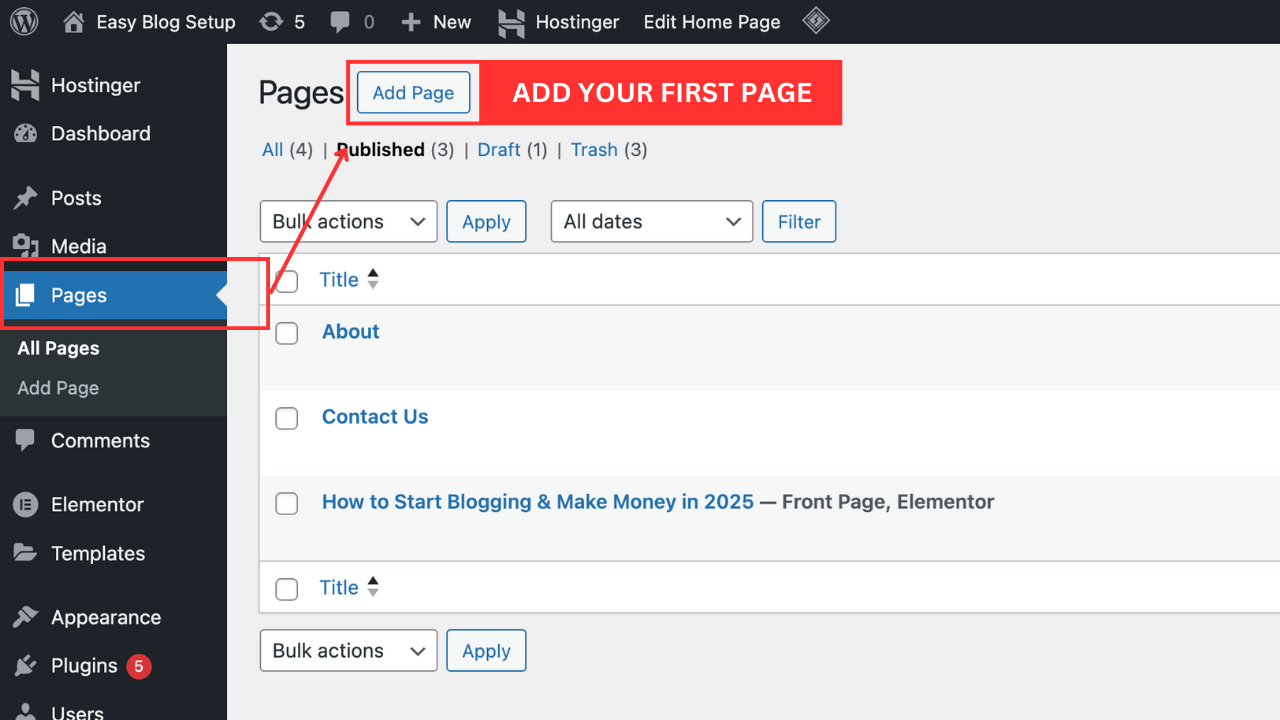
Quick Tip:
Don’t wait to be “big” to look professional. Having these pages in place builds trust, credibility, and opens doors to partnerships later.

Writing Great Content (That Hooks, Helps & Actually Gets Read)
You’ve set up your blog now what?
Now it’s time to create content that connects. The kind of content that…
- Gets shared
- Gets ranked
- Gets remembered
- Gets people coming back for more
Let’s break down exactly how to do that.
The Core Ingredients of High-Quality Blog Content
1. Originality
Don’t copy. Ever. Write in your own voice. Tell your own story. Share your own examples.
Real = relatable = readable.
2. Depth > Length
Longer content tends to perform better, but only if it’s helpful.
Aim for 1,500–2,500 words per post on key topics — break it down, explain, teach.
3. Formatting
No walls of text.
Use:
- Short paragraphs (2–4 lines max)
- Bullet points and numbered lists
- Headers (H2, H3) every few hundred words
- Images, gifs, or illustrations
The Ideal Blog Post Structure
1. Headline: Make it irresistible
- “10 Things I Wish I Knew Before Starting a Blog”
2. Hook – First 2 lines should stop the scroll
- Start with a question, stat, or bold statement
3. Introduction: Let them know what they’ll learn & why it matters
4. Body: Deliver the goods in sections
- Use real examples, step-by-steps, and tips
5. Takeaway/Action: What should they do next?
6. Call-to-Action (CTA): Ask them to comment, share, or sign up
Make It Engaging (Even If It’s Educational)
- Use a conversational tone
- Write like you’re explaining to a smart friend
- Ask questions to keep readers mentally involved
Use relatable humor when it fits
(“This step is easier than making ramen at 2am”)
Add Value with Visuals
- Use screenshots to demonstrate steps
- Add original photos if you have them
- Create infographics with free tools like Canva
- Always add alt text for SEO and accessibility
What Makes People Stay on Your Blog?
- Easy navigation
- Clear structure
- No pop-up overload
- Actual answers to what they searched for
- YOU: your voice, your story, your vibe
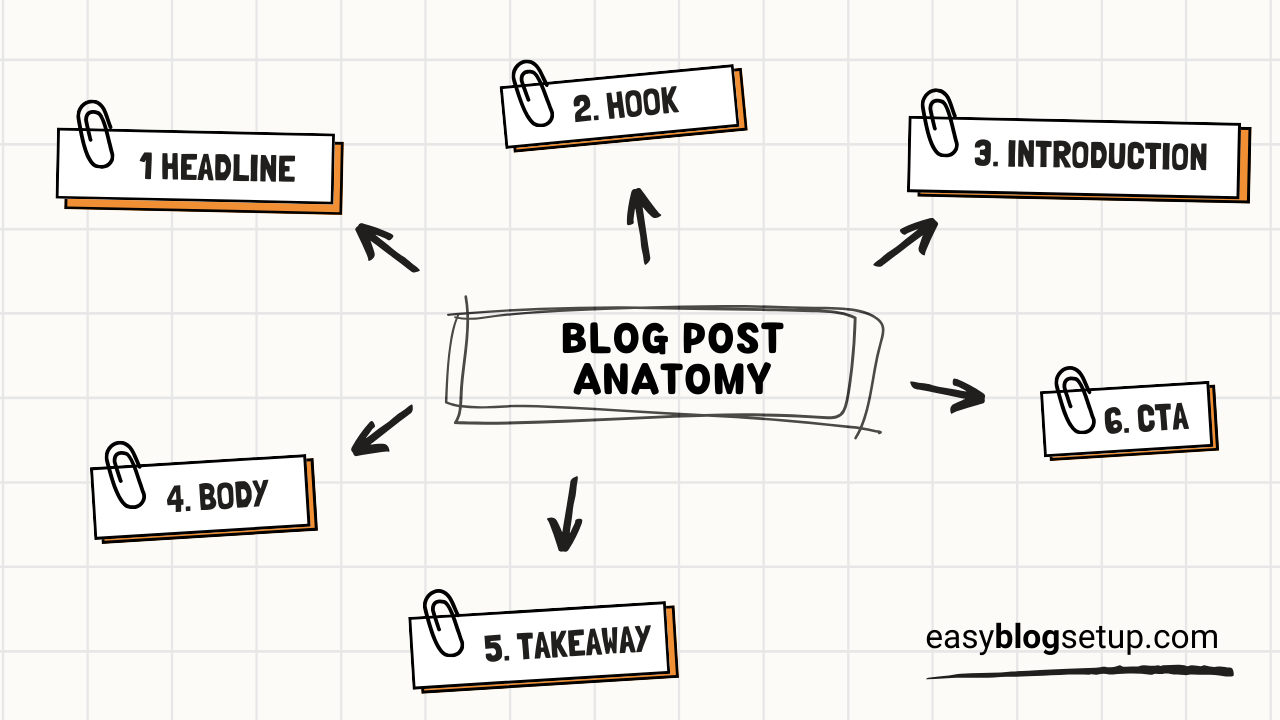
Quick Tip:
Write your first few posts with your ideal reader in mind. Picture one person. Talk to them directly. Help them solve one problem per post.

Promoting Your Blog (The Secret Sauce to Getting Traffic & Growing Fast)
So you wrote a killer blog post. You hit publish.
And then… crickets?
Here’s the hard truth:
You could write the greatest post of all time, but if you don’t promote it, no one’s going to see it.
Promotion = fuel for your blog’s fire.
The 5-Part Blog Promotion Game Plan:
1. Share It Like a Beast on Social Media
Pick 1–2 platforms where your audience hangs out, not everywhere.
How to do it:
- Create 2–3 variations of your post headline
- Use visuals (Canva graphics, quotes, carousel posts)
- Add relevant hashtags
- Tell a story in the caption that hooks them in
- Don’t just drop links give value first, then invite them to your blog
Platforms to use:
- Pinterest (underrated + search-based!)
- Twitter/X (for bold insights, threads)
- Instagram (carousel posts, stories)
- Facebook Groups (join niche communities)
- LinkedIn (if you’re in a professional or B2B niche)
2. Build an Email List (Even if You’re Brand New)
Why?
Social media algorithms change.
Your email list = your audience forever.
How to start:
- Create a freebie (PDF checklist, mini guide, template)
- Add opt-in forms using ConvertKit, MailerLite, or Flodesk
- Mention it in your posts, sidebar, and at the end of every article
3. Comment, Connect & Collab
Be a visible part of your niche.
- Leave meaningful comments on other blogs
- Shout out creators you admire
- Offer to guest post
- Join community chats, Twitter Spaces, or forums
- Link to others generously (they may return the favor!)
4. Optimize for Google (AKA: Let SEO Bring You Free Traffic)
SEO = Search Engine Optimization
This is how people find you when they Google something like:
“How to start a fitness blog in 2025”
Here’s the fast-track SEO checklist:
- One focus keyword per post
- Use that keyword in the: Title, URL, Meta description, First 100 words, Subheadings (H2s)
- Use internal links (link to other posts on your blog)
- Use external links (link to high-authority sources)
- Add image alt text
- Use a plugin like Yoast SEO or RankMath to guide you
5. Be Consistent & Stay Visible
- Post regularly (once/week or bi-weekly is great)
- Update old content (Google loves freshness)
- Reshare your best posts often
- Don’t be afraid to repeat your message, repetition = recognition
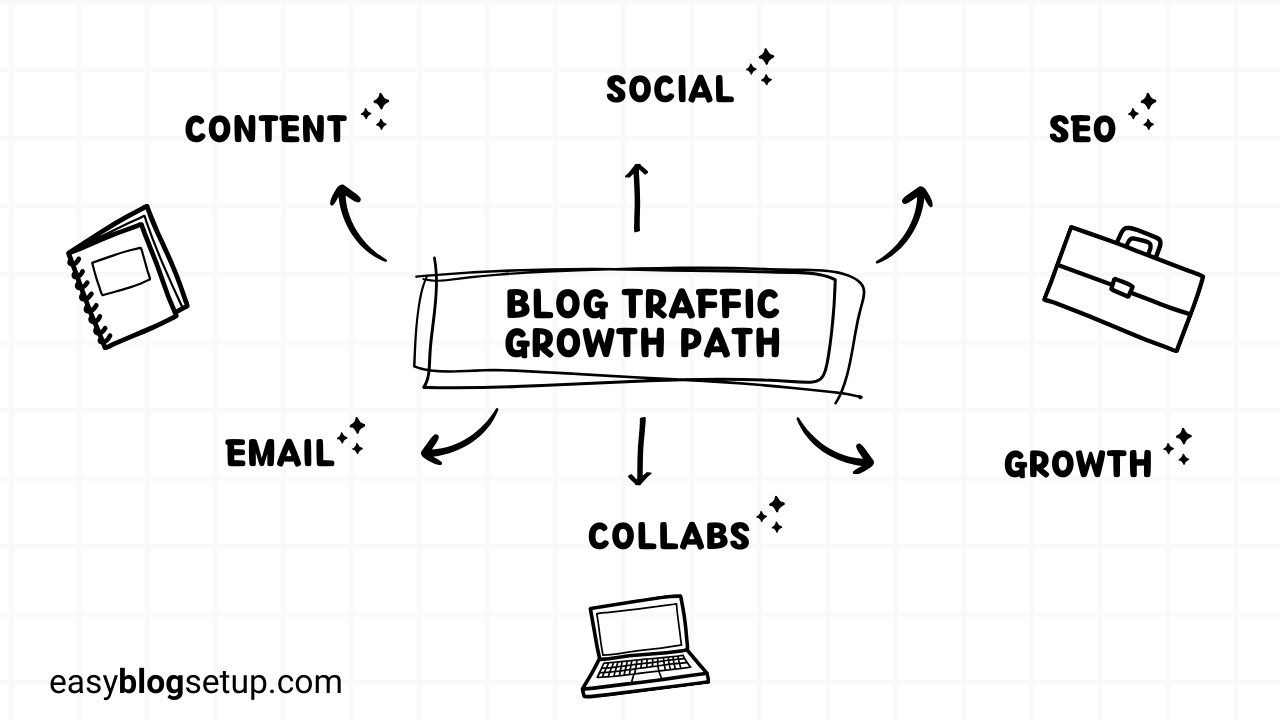
Quick Tip:
Promote each blog post at least 5–7 times in the first month. Don’t assume people saw it the first time.

How to Make Money from Your Blog (No BS, Just Real Strategies That Work in 2025)
You’ve done the setup. You’ve created content. You’re promoting like a pro.
Now you’re thinking: “Can I actually make money from this?”
The answer: YES.
And there’s not just one way to earn, there are multiple income streams you can build over time.
Let’s break them down.
1. Affiliate Marketing (Earn While You Recommend)
What it is: You recommend a product or service using your unique link → if someone buys, you earn a commission.
How to do it:
- Join programs like Amazon Associates, ShareASale, Impact, CJ, or niche-specific programs
- Write helpful, honest reviews and tutorials
- Add affiliate links in blog posts, resource pages, and newsletters
Example:
Post: “My 5 Favorite Budgeting Tools for 2025”
Link to affiliate tools like apps, planners, or courses.
2. Offer Services (Fastest Way to Start Making $$)
If you have a skill, your blog can be your portfolio.
Think:
- Freelance writing
- Graphic design
- Coaching or consulting
- VA services
- Social media management
- Web design
Add a “Work With Me” or “Hire Me” page with your services and contact form.
3. Sell Digital Products (Make It Once, Sell Forever)
This is where things get scalable.
You can create:
- Ebooks
- Templates
- Checklists
- Mini courses
- Notion dashboards
- Printables (great for parenting, fitness, finance niches)
Use tools like:
- Gumroad
- SendOwl
- Podia
- ThriveCart
Example:
A blog about productivity? Sell a digital planner or daily habit tracker.
4. Sponsored Content (Get Paid to Post)
Brands pay you to:
- Review their product
- Mention them in a post
- Share them on social media
Tip: You need some traffic or an engaged audience first.
Start by building niche authority, then pitch to brands or join platforms like:
- Intellifluence
- Collabor8
- Influencity
- TapInfluence
5. Display Ads (Hands-Off Passive Income)
Once you’re getting traffic (around 10K+ monthly views), apply for ad networks:
- Google AdSense (starter option)
- Ezoic (for smaller blogs)
- Mediavine (for high-traffic blogs)
You earn when people visit and view (or click) ads on your blog.
6. Launch a Membership or Community
Once you’ve built a loyal tribe, offer access to:
- Exclusive content
- Q&A sessions
- Live chats
- Templates/tools
Use:
- Patreon
- BuyMeACoffee
- Memberful
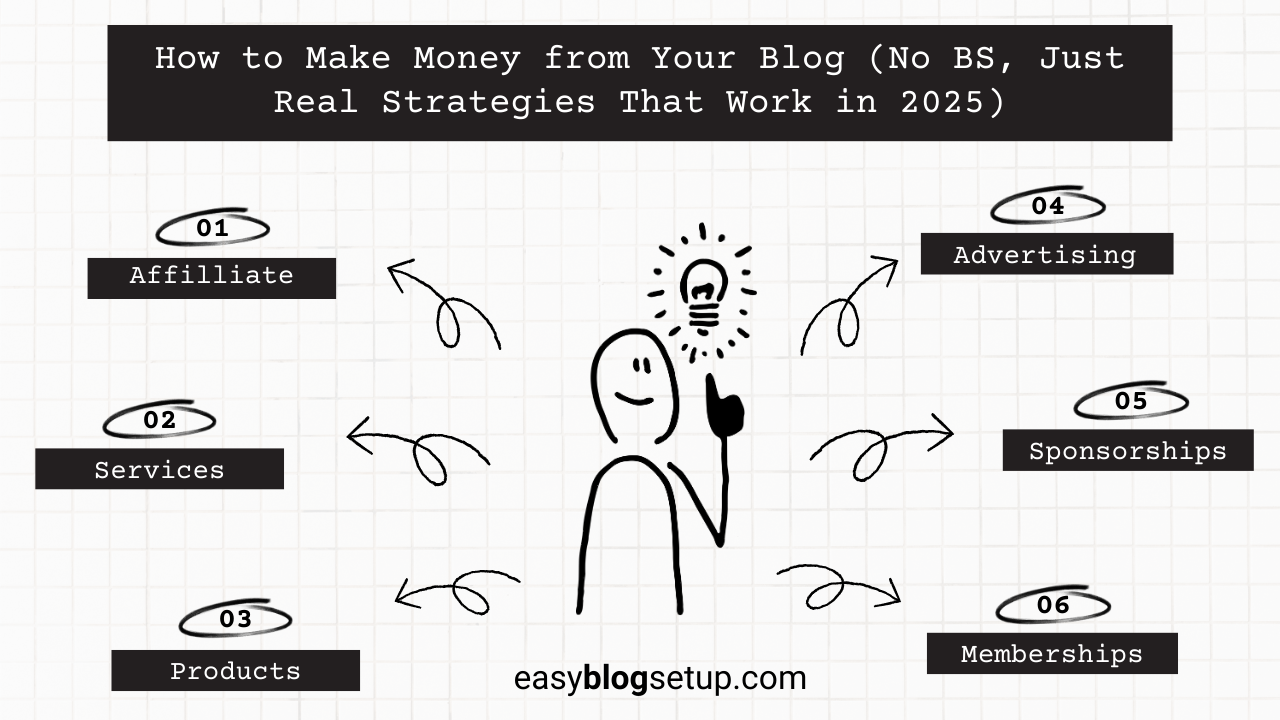
Important Truth:
You don’t need a million views to start making money.
You need:
- Helpful content
- Clear offers
- A focused niche
- Real trust
Quick Tip:
Start with affiliate marketing + 1 service or product. Don’t try everything at once. Stack income streams over time.

Blogging FAQs
(For Total Beginners Who Don’t Want to Google It Again)
You’ve got questions? We’ve all had them.
Here are the realest, most common, and least filtered blogging questions, answered clearly and with zero fluff.
Q1: Do I need to know how to code to start a blog?
Nope. Zero code required.
WordPress does the heavy lifting think of it like drag-and-drop magic. You’ll be customising with clicks, not code.
Q2: How much does it cost to start a blog?
- Domain: ~$10–$15/year
- Hosting: ~$3–$8/month (if you buy yearly)
- Theme: Free or ~$40–$60 for premium
Total: You can launch a legit blog for under $100
Q3: How soon can I make money?
It depends on how much effort you put in, but many bloggers start making money in 3–6 months, some even faster if offering services or using affiliate links early.
Q4: How often should I publish new blog posts?
Quality > quantity, but aim for:
- 1 post per week if possible
- 2 per month minimum (especially when starting)
Consistency wins long-term.
Q5: What if I have multiple passions? Can I blog about everything?
You can, but it’s better to start with one focused niche.
Once you grow an audience and authority, you can branch out. Start focused, grow wide.
Q6: What if someone already took my blog name?
It happens. Try variations:
Add words like “the,” “my,” or “hq”
Use a different extension like .co or .blog (only if .com is unavailable)
Brainstorm alternatives, don’t get stuck!
Q7: How long should a blog post be?
Ideal: 1,500–2,500 words for in-depth content
Shorter is okay for personal or quick tip-style posts, but longer content ranks better in Google.
Q8: Do I need to be on social media to grow my blog?
Not required, but very helpful.
Pick just 1–2 platforms where your audience hangs out, you don’t need to be everywhere.
Pinterest, Instagram, and Twitter work great for most niches.
Q9: Should I use WordPress.com or WordPress.org?
Always go with WordPress.org.
You get full control, can monetize, install plugins, and own your blog completely.
Q10: Is it too late to start a blog in 2025?
Not even close.
If you’re willing to show up, write honestly, and serve a real audience, there’s room for YOU.
The internet is infinite. Your voice belongs here too.
(WordPress.com is limited and not ideal for serious bloggers.)
Quick Tip:
Don’t let overthinking kill your momentum. Every blogger you admire once Googled “how to write a blog post” too.

Final Words & Encouragement (Because You’re Closer Than You Think)
Let’s take a second.
Look at what you’ve done or are about to do.
You’ve taken this seed of an idea “I kinda want to start a blog…”
And now you’re standing at the edge of something that could completely change your life.
And no, that’s not hype. That’s reality.
Blogging Isn’t Just About Posts.
It’s about:
- Building your brand
- Owning your platform
- Sharing your story
- Helping real people
- Creating something that keeps giving, years from now
You don’t need 100K followers.
You need:
- A voice
- A purpose
- A little patience
- And a whole lot of belief in yourself
Every successful blogger once hit “Publish” on a post that no one read.
Then they did it again. And again.
And eventually, it snowballed.
So Here’s Your Permission Slip:
- Start imperfectly
- Write messy drafts
- Hit publish when you’re 80% ready
- Show up even if only 3 people read it
- Keep going even when the results are quiet
Your blog won’t grow overnight. But it WILL grow, if you don’t quit.
One Day, You’ll Look Back at This Page…
…And be so freaking glad you didn’t talk yourself out of it.
You’ll have:
- A blog you’re proud of
- Readers who trust you
- Content that ranks
- Income streams flowing
- And a brand that’s truly yours
So take the next step.
Write the next word.
Click “Publish.”
And let the internet meet the real you.


